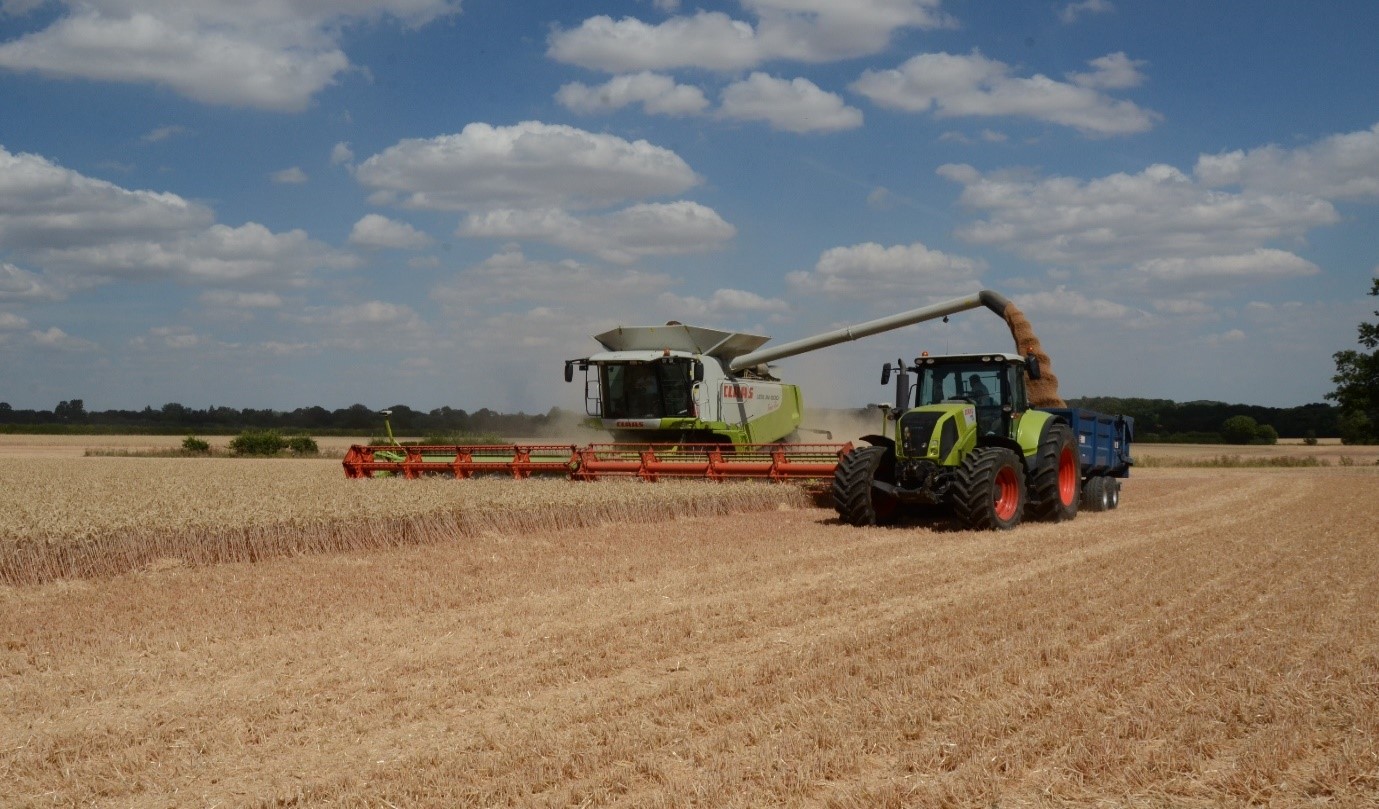If you would like a printed copy of any of our back issues, then they can be purchased on Farm Marketplace. You can also download the PDFs or read online from links below.
-
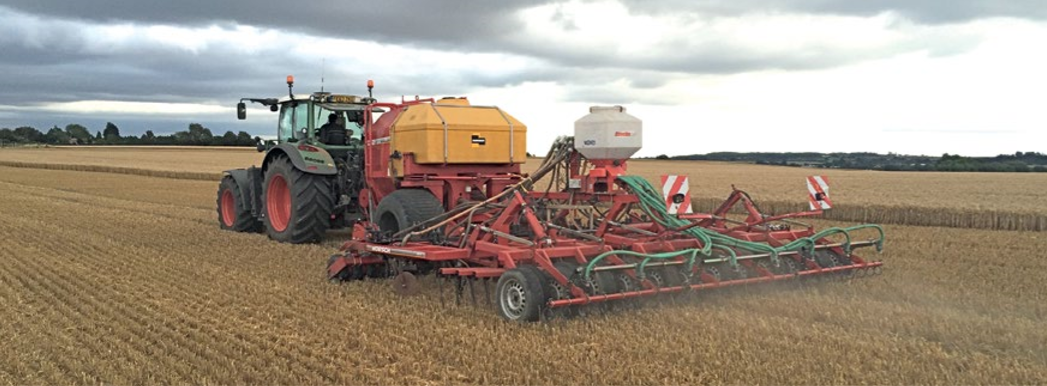
How To Start Drilling For £8K
Clive Bailye’s seed drill of choice is his 6m John Deere 750A , which has been used exclusively for 3-4 seasons. Last year, with an increased acreage, the founder and publisher of this Direct Driller magazine thought a second seed drill was necessary. Having just the one machine was a risk and in a difficult season would mean drilling was delayed. He looked around and found a good condition Horsch CO6 tine drill advertised in Germany.
Words and pictures by Mike Donovan
After delivery he rebuilt the coulters to a narrow profile so as to reduce soil disturbance. He says the tine drill is very useful driling after straw crops such as osr and also through the straw on second crop cereals.
Buying the drill from a German farmer was not particularly complicated, and provided him with a higher spec machine than Horsh sell in the UK. The seed dart tyres are much wider, and the machine is fitted with blockage monitors as well as full width front packers and also a liquid fert application system.
A sheaf of photos were taken, and Clive then asked for some of specific parts to show wear. The deal was done at under £5,000 which Clive says is the market value of these machines which are too large for small farmers to buy. Original owners like to buy new and sell when the machine is still in good condition.
Narrow tines with wear tiles
@Clive knew he wanted to make changes, substituting the Horsch tines and coulters for something far narrower, and has ended up getting his own design of tine made, which has a wear tile made from Ferobide, far harder than tungsten. The drill is on the farm primarily for osr and 2nd crop cereals drilled into chopped straw and the 25cm spacing is okay for these crops.
Comments on Clive’s on-line forum, TFF, said the drill many not be so good with beans, as the slot is a mere 12mm wide. And in barley the spacing may well be too wide as it needs to be thick. Clive points out that the seed pipe can actually be a bit wider than 12mm as it is in the shadow of the point. It would be good to have the option of using it for beans.

Above left: The cheap CO6 is being calibrated ready for its first outing

Above right: The adapted Horsch is being filled by the home built drill logistics trailer with seed and liquid starter fert.
Getting around the German instructions
The Horsch came, of course, with a control box and instructions in German. More on-line discussion revealed that English instructions were available on the Horsch website, and another explained that Horsch was sourcing some of these parts from Agton in Canada anyway. Zealman from New Zealand explained that the button marked with callipers should be held down for around 5 seconds. The menu is where you adjust the tramline sequence, valve layout and row numbers.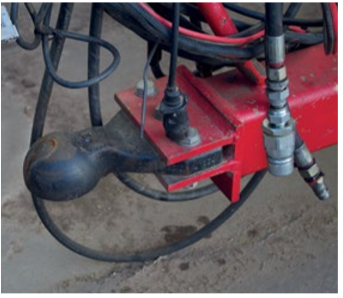
Ball hitch is a continental standard and provides a positive connection between tractor and drill

The Stocks Wizard has a rotor modified for Avadex which otherwise leaks everywhere
A Stocks Wizard is on the back of the drill and used for Avadex. Here again the knowledge of actual farmers is helpful. Alistair Nelson warned that the rotor and the surrounding shroud need to be changed, and he got good advice “from Rick at Stocks”. Clive has the same setup on the 750A and says that the Avadex leaks everywhere unless the modification is made. The drill was acquired and modified in 2016 and the results have been excellent.
The machine went through the residue without many problems and having the second drill has meant more timely planting. Clive has shown that moving into No-Till is not the expensive exercise so many farmers think it might be. The total cost, after modifications which included replacing all tines and coulters, was under £8,000.
Author Mike Donovan writes: we have featured a number of home made direct drills in @Practical Farm Ideas, and are always interested in seeing more. Please contact mike editor@farmideas.co.uk or 07778877514.
-
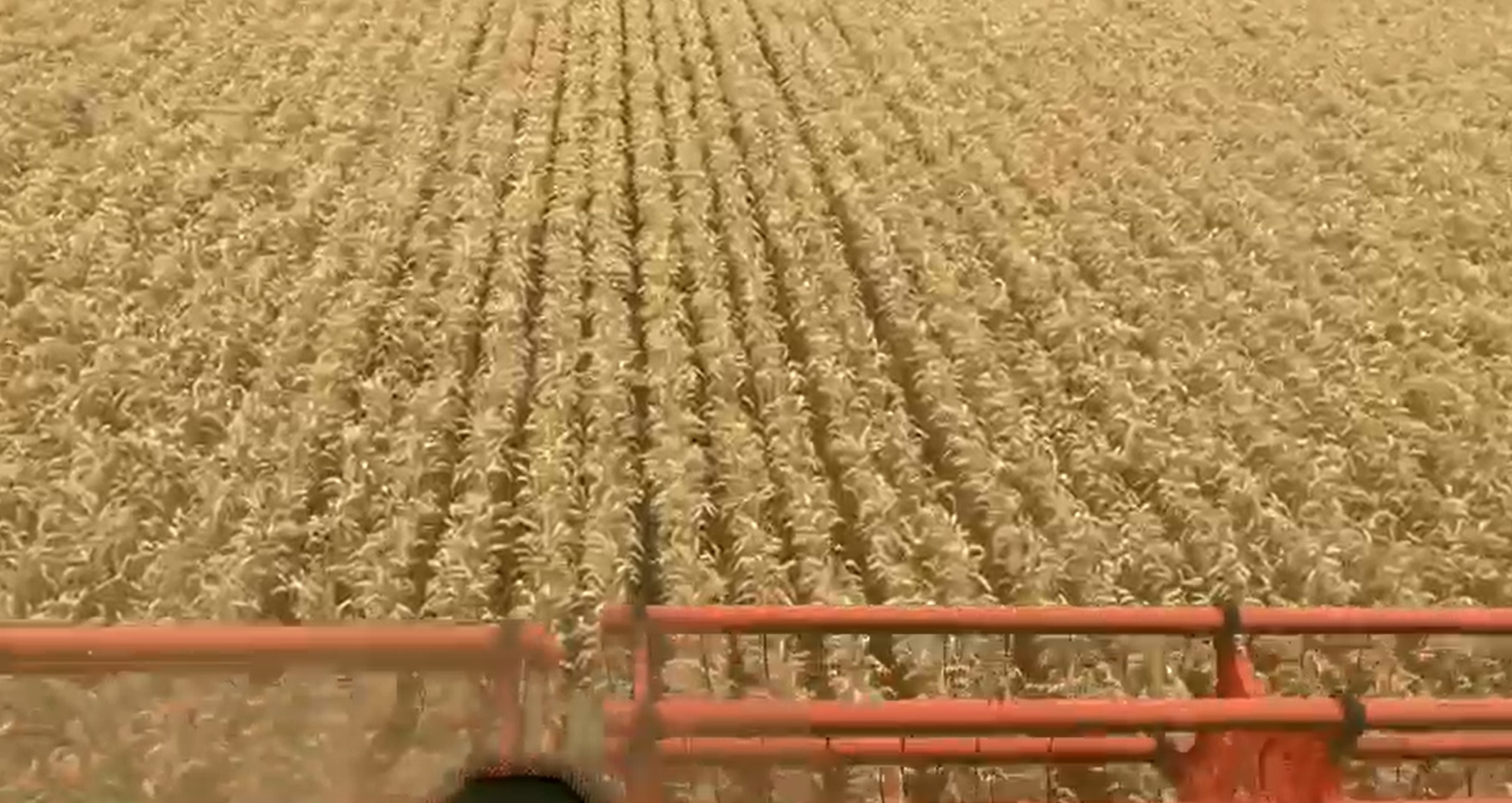
Another Extradordinary Year
Written by James Warne from Soil First Farming
What an extraordinary growing season we seem to have had. In a nutshell, very low rainfall, low temperatures until June and good levels of solar radiation (sunshine) resulting in generally good yields with good specific weight and moderate protein. Especially so as most crops senesced approximately 2 weeks earlier than normal.
All the more extraordinary is where we have, once again, been trialing reduced nitrogen rates on production we have seen very little difference in final yield between standard N rates and reduced N rates (until we reach a critical level, then yield drops significantly). Where we have found yield difference this comes from lower grain weight as opposed to reduced plant counts or tiller numbers. So what can we draw from this wealth of variables? Firstly, autumn 2021 was the kindest drilling season we have had for a couple of years suggesting that most crops went into good soil conditions backing up the adage ‘well sown-half grown’! the autumn and winter that followed was certainly dryer and in some areas was probably below average on the rainfall scale suggesting that crops rooted well.
Winter was also very mild with very few days of frost and certainly no prolonged periods of cold weather. Wheat tends to be growing at around 5’C and above and I believe that the crops were growing most of the winter, albeit very slowly probably contributing to root mass development as much as above ground vegetative growth.
Temperature
One of the greatest contributing factors in this year’s yield-fest has been the temperature, or rather lack of if we cast our minds back to the early spring and summer. For the majority of us the temperatures were in the comfortable mid to high teens (celcius) occasionally reaching the low 20’s but never exceeding this until mid-June.
Contrary to popular belief high-temperatures can be one of the greatest yield reducing factors for wheat as it can be sensitive to high temperatures throughout its growth cycle. It is, however, particularly to heat during the period from booting, through ear-emergence and flowering. This sensitivity then reduces after flowering trough grain-fill and maturity. Research shows temperature effects can start from the mid-late 20’s and become significant once into the 30’s. This is particularly so during the period of pollen formation and fertilisation.
Typically wheat is in flower around the second wheat in June (assuming the midlands of the UK). This occurred 7-10 days earlier this around, early June. The first really warm temperatures occurred around the 15th June onwards this year. By which time wheat had passed through the temperature critical period of pollen formation and flowering. From then on the temperatures typically remained in the low 20’s throughout June and into July when the skies cleared and we had prolonged periods if high 20’s-30’s and clear skies. This warmth and sun, combined with large soil moisture deficits, lead to rapid senescence and ripening. But the critical period of reproductive growth (stem extension and ear formation through to flowering) occurred during steady consistent conditions.
The high temperatures came too late to have any potential to reduce yield. Although those in the very dry east of the country probably found the lack of moisture contributed to a drop in yield.
Nitrogen
It is generally accepted that the crop only receives half its nitrogen requirement from that we apply. The other 50% comes from or via the soil. With the majority of the nitrogen being taken up in the nitrate form which is very water soluble it is assumed that the plant takes up most of its nitrogen as nitrate in the soil water.
With the bulk of the uptake happening from stem extension through to ear emergence. As I have already mentioned above a large chunk of the UK was very dry during this period of April & May with some areas receiving zero rainfall, yet crops were still able to access the nitrogen they required for canopy and ear development. Although it seems perhaps not enough to assimilate into protein but that may also be attributed to sulphur availability.
What is really interesting though is where we had reduced the soil applied N by half, combined with a small amount of foliar applied N this gave a very similar yield to wheat which had received a typical nitrogen dose. Where we had dropped the soil applied N further we did start to see a yield drop. I must stress these results were consistent on farms which have been practicing carbon building practices as in a Conservation Agriculture strategy, where we believe there to be a greater supply of N available for mineralization by the soil biology.

Although another question must surely be if the soil was moisture deficient the biology must surely have been dormant and therefore unable to mineralise the nitrogen! It’s also worth noting that while it developed into another low disease year we saw a marked increase in mildew develop in the high N plots compared to lower total N plots. Never forget that nitrogen can help drive disease levels within the crop. Finally, one of the most perplexing outcomes of this year is if the crop is able to produce the yields we have had when its growing cycle was at least two weeks shorter than average, why do we spend so much time and effort in trying to keep the canopy green? If there is one thing we have been shown this year it’s the lifespan of the crop has no direct influence on the final yield…..
-
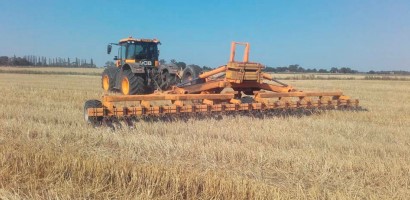
Sometimes You Have To Disagree
Written by Tony Gent
A couple of articles caught my interest in the July additional of this Magazine, First What’s Your Colour written by James Warne and Farmer Focus by Andrew Ward. The theme of both is somewhat similar in questionable understanding the principle of how soil degradation works and putting in place appropriate practice to start a sequence of improving organic matter and resulting biology.

Since the evolvement of tillage mainly to establish a single species crop with reduce competition from other species – a weed, mass food production evolved highly successfully. What we now understand is that success was based on what some compared to mining products from the soil. The way soil evolved over millions of years to work before man’s intervention vegetation growth and subsequent die back were in balance I.E., organic carbon, fertility and nutrition release were at the same rate with no artificial soil movement taking place.
When soil fertility is naturally high soil movement results in robust crops due to the cultivation induced increased rate of nutrition release. This is particularly so as soil movement technology gets more and more aggressive particularly with development of inversion tillage such as the plough. What we now have as a result of cultivation causing instance of retention and release is soil which is out of balance with its biology resulting in degradation or as we say total mining of the soil-based resource.

The dilemma so many farmers are faced with, with soil in this situation is putting in place practices that turn the corner towards restoration of biology and protecting the short-term risk as they see it to the income stream from the farm. Also, judgement and assessment of what’s happening can become massively clouded and confusing with reduced soil movement reducing artificial soil structural correction, but which still compromises natural biological build up.
Particularly farmers with heavily degraded soil that has been vigorously attacked with more and more power and forced soil manipulating technology for timelier establishment and finer seed beds. The awareness of what other farmers have achieved in a No-Till position where they are growing very respectable cost-effective crops doing nothing. Their thought process is all too often that’s ok but I think there is an opportunity to do less, but if I continue to do something it’s got to be better than doing nothing. We have learned that again particularly with heavily degraded soil that logic is partly correct, but it must be applied from a different standpoint.
It doesn’t work if just removing some elements of what you are doing now and leave others in is “OK I’m doing less”. The problem is that what you were doing even with so-called min-till had an element of primary tillage or initial soil breaking in it, followed by seedbed preparation either prior to drilling or in conjunction with drilling. The problem as I have described is often a bad compromise first not achieving carrying soil along in its degraded state or doing a suitable operation to not compromise biology recovery and so just bumping along in the tough of doing neither of artificially doing natures job completely or treating the soil correctly to allow biology to recover and the soil and moving to a point of soil largely looking after itself as nature intended.
The first absolute rule in all this is do nothing if it is not needed and then only in suitable weather and rotational situations and opportunity. Also experience has shown us that grass related crops I,E, cereals have much stronger rooting than many break crops and usually tolerate heavily degraded soil with little or no loss of yield, so long as establishment is robust and there are no compaction or drainage issues. Break crops such as oil seed rape and beans though are weaker rooting and soon show their dislike to less than reasonable soil structure.
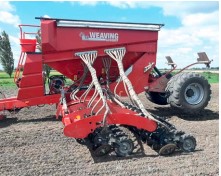
When you stop tillage of degraded soil so long as the previous crop and this is by far the best way to judge the structural state of a field was robust and suffered no signs of compaction or drainage problems and no severe damage was done to the soil removing the previous crop, then it’s completely rational to expect if its grown one successful robust crop why shouldn’t it grow another one, without any interference with the soil. With the first year or two of No-Till that’s usually the case.
But after that an element of weather luck and rotational circumstances creep in. The soil starts to forget the artificial structuring help you have been giving it and as I have said is yet to be at the stage to compensate for this. In practice and this is where weather luck starts to play a part usually with our maritime climate a wet sowing period compromises crop establishment and results in a less than ideal robust crop. Because soil recovery relies on the soil being active and full of roots and activity,
We have found the approach to the doing something to help for us has been low disturbance vertical tillage. With us there are two stages to this – repair and get soil going in the right direction and the much more laid-back simple rotation opportunistic rotational maintenance, of which as biology increases you need less and less. Very important you must not confuse soil hard or firmness with soil compaction – soil is naturally hard or firm, particularly in dryer conditions, but with the honeycomb built up as biology is restored firmness is not a problem. The big big misconception is trying replicate this structure with cultivation, it does not work like that. The more you cultivate the soil structural the weaker it becomes and wet and dry conditions and trafficking it just slumps together into one big hard lump or slush, and the cycle of obliterating it with cultivation must begin again. Also worms and microbes have no chance in this cycle of obliteration to slump.

Methods of establishment also plays a part in this with a fixed tine or disc approach. Tines range from the type that moves all or most of soil creating an affect that’s basically one pass cultivation and obviously compromises massively No-till and biology recovery to a very narrow low disturbance tine which is much better, but most still have some element of disruption and inversion effect on the soil. All tines have the disadvantage of blockage in residue, especially in cover crops. Discs generally have much lower surface disturbance and are much better at handling residue and as with tines there are various different approaches to design.
The main difference is that most create the opening by displacement of the soil sideways soil against soil, which results in compression soil damage and smear in wet conditions that is synonymous with most design limitations. An under-cut disc such as the Weaving GD is much kinder to the soil as there is little or no sideways movement and the opening is created with a natural sleight upwards action, resulting in minimal disturbance and pressure on the soil allowing the seed to be placed under the tilth. Soil friction is generally less than a tine because the disc rotates with the soil flow, resulting in less pressure needed to firm the soil around the seed leading to reduced shrinkage and slot opening, also the seed is predominantly placed to the side away from the primary cut therefore generally slightly away from any hair pinned residue.

Recently the theory of cover cops has come to the forefront, which is great, and no doubt could help with particularly the transition enormously, but the practicality has many challenges, particularly with the establishment window. As I write – ok its early and we have plenty of time and opportunity, but no moisture and as we have seen with small seed crops if you put them in the ground and they don’t immediately grow they lose vigour and often are a complete failure, even when it does eventually rain. Wet seasons often are cold and late also which compromises establishment before the autumn growing period tails of into winter. Also, with a later harvest workload becomes a compromise and cash crops must take precedence.
By all means embrace no-till, especially to address soil degradation and make sure your methods facilitate an improvement in soil biology. This is absolutely vital to allow the soil to recover, some appropriate help maybe needed to win in the long term, together with a little patience.
-
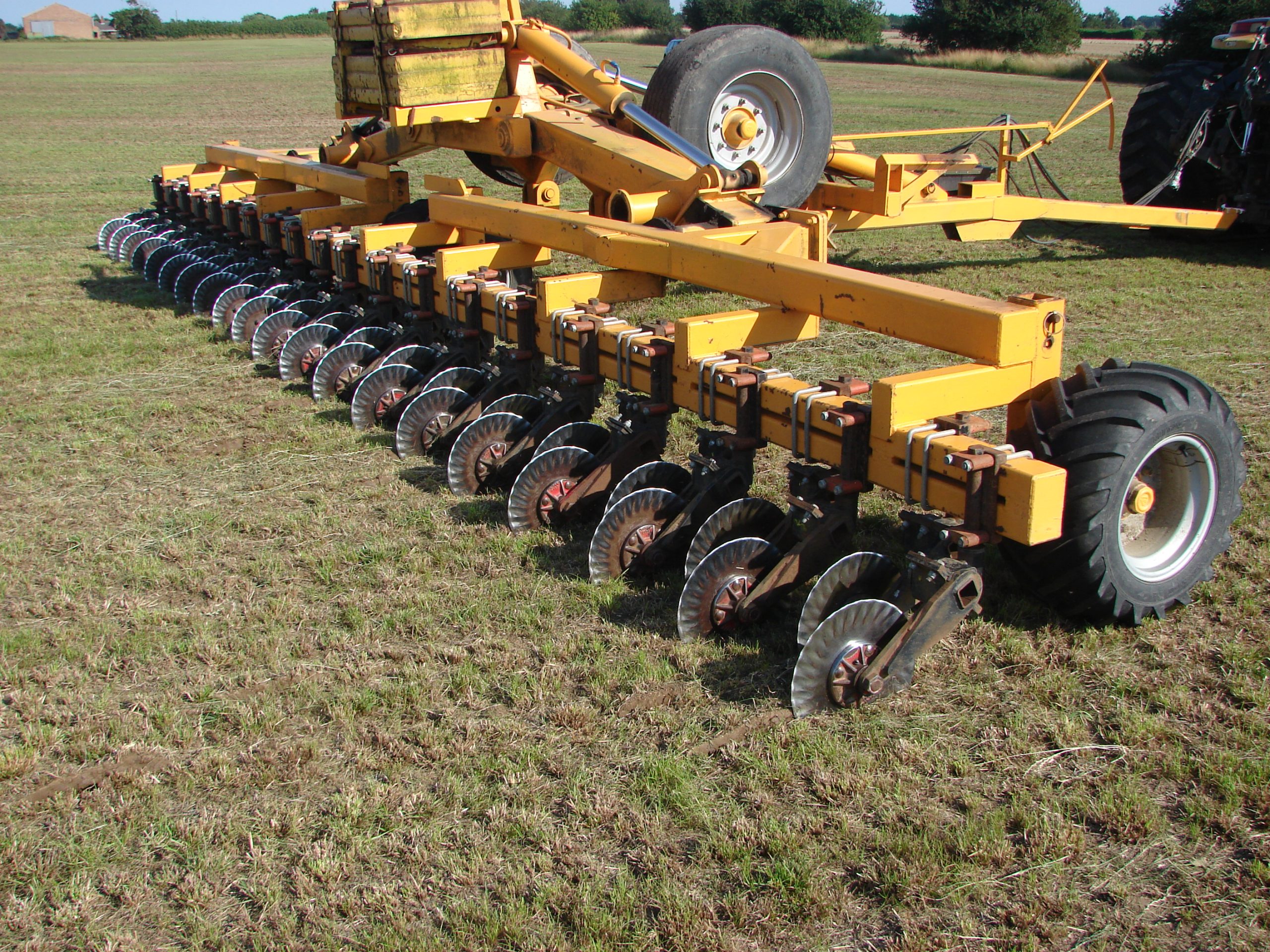
Be careful about doing nothing
Written by Tony Gent
It doesn’t work if just removing some elements of what you are doing now and leave others in is “OK I’m doing less”.
A couple of articles caught my interest in the July additional of this magazine, first What’s Your Colour written by James Warne and Farmer Focus by Andrew Ward. The theme of both is somewhat similar in questionable understanding the principle of how soil degradation works and putting in place appropriate practice to start a sequence of improving organic matter and resulting biology.
Since the evolvement of tillage mainly to establish a single species crop with reduce competition from other species – a weed, mass food production evolved highly successfully. What we now understand is that success was based on what some compared to mining products from the soil. The way soil evolved over millions of years to work before man’s intervention vegetation growth and subsequent die back were in balance so organic carbon, fertility and nutrition release were at the same rate with no artificial soil movement taking place.
When soil fertility is naturally high soil movement results in robust crops due to the cultivation induced increased rate of nutrition release. This is particularly so as soil movement technology gets more and more aggressive particularly with development of inversion tillage such as the plough. What we now have as a result of cultivation causing instance of retention and release is soil which is out of balance with its biology resulting in degradation or as we say total mining of the soil-based resource.
The dilemma so many farmers are faced with, with soil in this situation is putting in place practices that turn the corner towards restoration of biology and protecting the short-term risk as they see it to the income stream from the farm. Also, judgement and assessment of what’s happening can become massively clouded and confusing with reduced soil movement reducing artificial soil structural correction, but which still compromises natural biological build up.
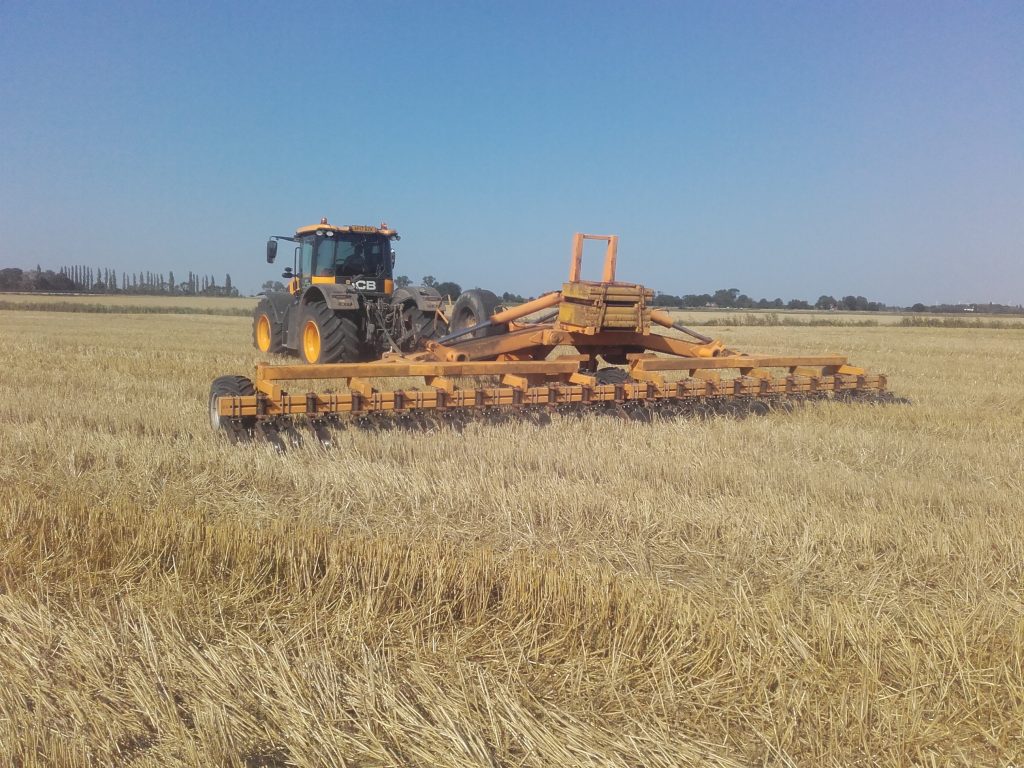
Particularly farmers with heavily degraded soil that has been vigorously attacked with more and more power and forced soil manipulating technology for timelier establishment and finer seed beds. The awareness of what other farmers have achieved in a No-Till position where they are growing very respectable cost-effective crops doing nothing. Their thought process is all too often that’s ok but I think there is an opportunity to do less, but if I continue to do something it’s got to be better than doing nothing. We have learned that again particularly with heavily degraded soil that logic is partly correct, but it must be applied from a different standpoint. It doesn’t work if just removing some elements of what you are doing now and leave others in is “OK I’m doing less”. The problem is that what you were doing even with so-called min-till had an element of primary tillage or initial soil breaking in it, followed by seedbed preparation either prior to drilling or in conjunction with drilling. The problem as I have described is often a bad compromise first not achieving carrying soil along in its degraded state or doing a suitable operation to not compromise biology recovery and so just bumping along in the tough of doing neither of artificially doing natures job completely or treating the soil correctly to allow biology to recover and the soil and moving to a point of soil largely looking after itself as nature intended.
The first absolute rule in all this is do nothing if it is not needed and then only in suitable weather and rotational situations and opportunity. Also experience has shown us that grass related crops such as cereals have much stronger rooting than many break crops and usually tolerate heavily degraded soil with little or no loss of yield, so long as establishment is robust and there are no compaction or drainage issues. Break crops such as oil seed rape and beans though are weaker rooting and soon show their dislike to less than reasonable soil structure.
When you stop tillage of degraded soil so long as the previous crop and this is by far the best way to judge the structural state of a field was robust and suffered no signs of compaction or drainage problems and no severe damage was done to the soil removing the previous crop, then it’s completely rational to expect if its grown one successful robust crop why shouldn’t it grow another one, without any interference with the soil. With the first year or two of No-Till that’s usually the case. But after that an element of weather luck and rotational circumstances creep in. The soil starts to forget the artificial structuring help you have been giving it and as I have said is yet to be at the stage to compensate for this. In practice and this is where weather luck starts to play a part usually with our maritime climate a wet sowing period compromises crop establishment and results in a less than ideal robust crop. Because soil recovery relies on the soil being active and full of roots and activity,
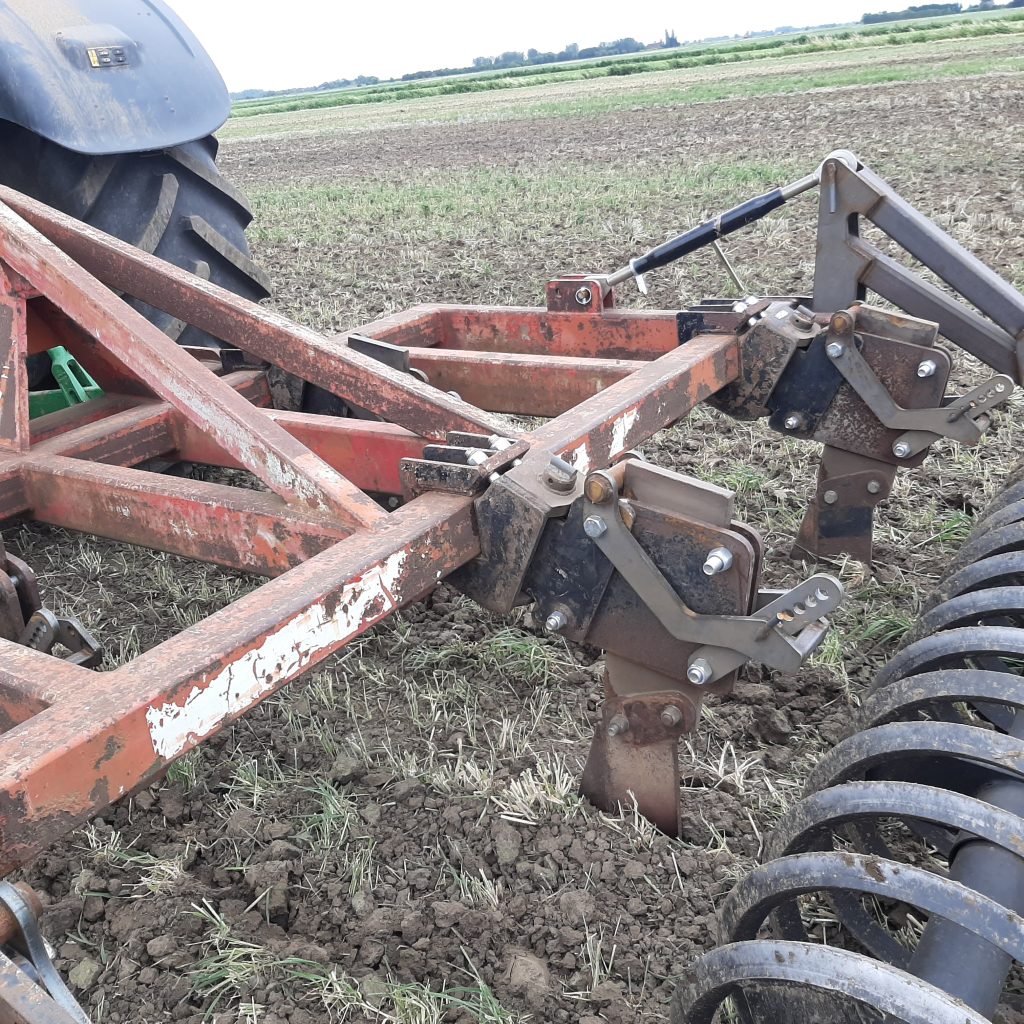
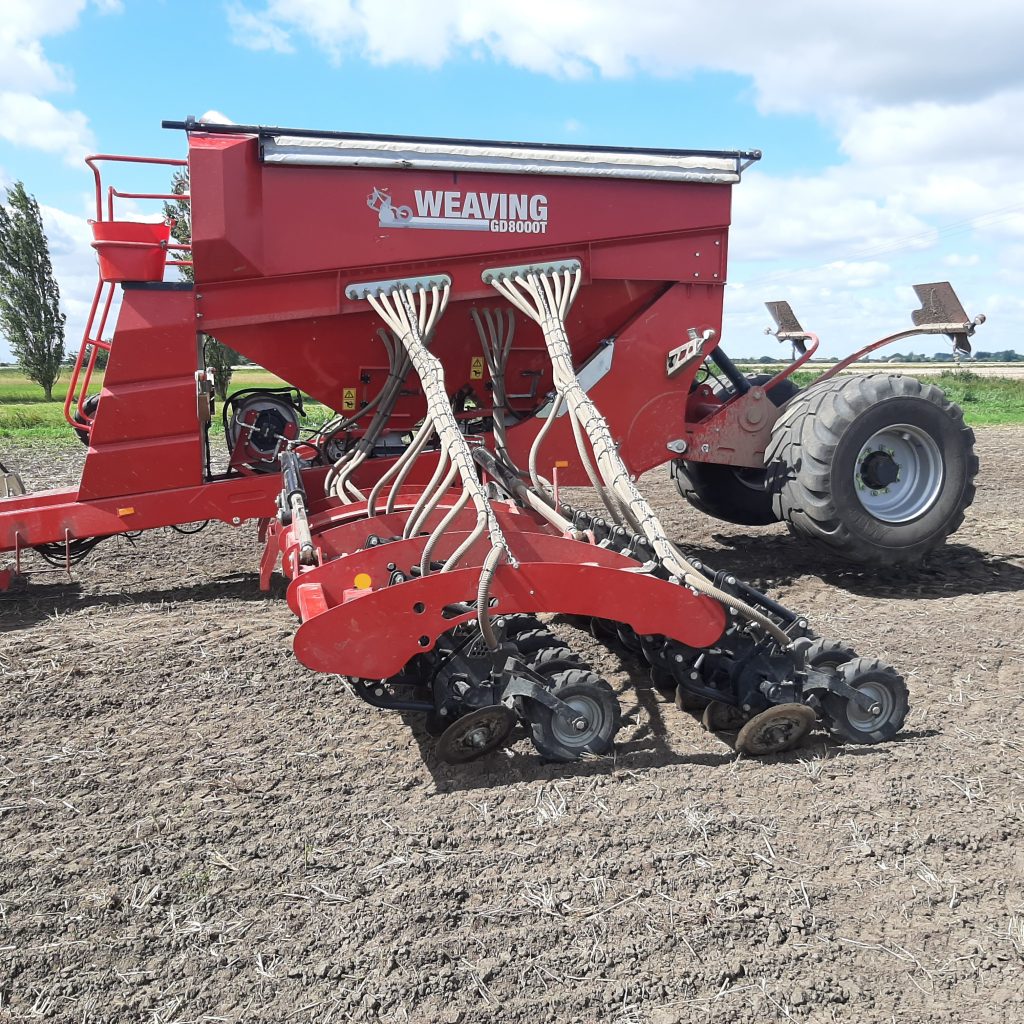

We have found the approach to the doing something to help for us has been low disturbance vertical tillage. With us there are two stages to this – repair and get soil going in the right direction and the much more laid-back simple rotation opportunistic rotational maintenance, of which as biology increases you need less and less. Very important you must not confuse soil hard or firmness with soil compaction – soil is naturally hard or firm, particularly in dryer conditions, but with the honeycomb built up as biology is restored firmness is not a problem. The big big misconception is trying replicate this structure with cultivation, it does not work like that. The more you cultivate the soil structural the weaker it becomes and wet and dry conditions and trafficking it just slumps together into one big hard lump or slush, and the cycle of obliterating it with cultivation must begin again. Also worms and microbes have no chance in this cycle of obliteration to slump.
Methods of establishment also plays a part in this with a fixed tine or disc approach. Tines range from the type that moves all or most of soil creating an affect that’s basically one pass cultivation and obviously compromises massively No-till and biology recovery to a very narrow low disturbance tine which is much better, but most still have some element of disruption and inversion effect on the soil. All tines have the disadvantage of blockage in residue, especially in cover crops. Discs generally have much lower surface disturbance and are much better at handling residue and as with tines there are various different approaches to design. The main difference is that most create the opening by displacement of the soil sideways soil against soil, which results in compression soil damage and smear in wet conditions that is synonymous with most design limitations. An under-cut disc such as the Weaving GD is much kinder to the soil as there is little or no sideways movement and the opening is created with a natural sleight upwards action, resulting in minimal disturbance and pressure on the soil allowing the seed to be placed under the tilth. Soil friction is generally less than a tine because the disc rotates with the soil flow, resulting in less pressure needed to firm the soil around the seed leading to reduced shrinkage and slot opening, also the seed is predominantly placed to the side away from the primary cut therefore generally slightly away from any hair pinned residue.

Recently the theory of cover cops has come to the forefront, which is great, and no doubt could help with particularly the transition enormously, but the practicality has many challenges, particularly with the establishment window. As I write – ok its early and we have plenty of time and opportunity, but no moisture and as we have seen with small seed crops if you put them in the ground and they don’t immediately grow they lose vigour and often are a complete failure, even when it does eventually rain. Wet seasons often are cold and late also which compromises establishment before the autumn growing period tails of into winter. Also, with a later harvest workload becomes a compromise and cash crops must take precedence.
By all means embrace no-till, especially to address soil degradation and make sure your methods facilitate an improvement in soil biology. This is absolutely vital to allow the soil to recover, some appropriate help maybe needed to win in the long term, together with a little patience.




-

Drill Manufacturers In Focus…

HORSCH AVATAR 12.25 SD UPDATED WITH NEW EQUIPMENT OPTIONS
The latest 12m HORSCH Avatar 12.25 SD, launched in early 2022, has been updated with new equipment options, including a new control concept. The intuitive handling system is based on ISOBUS and makes it easier for the farmer to adjust, operate and monitor the drill. The terminal interface can be adapted to the user’s requirements and, with the new hardware and software, HORSCH has created a platform which can supply an almost unlimited number of components when metering.
Thanks to the well-proven folding design the transport dimensions are very compact. With an outside width of 3 metres, it is also ideal for road transport. There are various tyre versions from 520 to 900 tyres and twin tyres.

The newly developed seed hopper platform has a capacity of 6500 litres and can be ordered as a double hopper with a 60:40 ratio. To increase the range further, especially for rape seed, a MiniDrill G&F is now available as an option. This additional hopper has a capacity of 400 litres and is often used for seed, granulates or slug pellets. Filling stops can be reduced and up to 3 components can be metered at the same time. The seed wagon layout increases the drilling window with the large tyre widths reducing compaction even in wet soil conditions. The double support wheels at the wings ensure low tracks and optimum adaption to the soil. With its 1-row design with SingleDisc coulters and a row spacing of 25cm, the Avatar 12.25 SD is ideal for mechanical population control, but also for the most different sowing methods, such as direct seed, mulch seed and into standing catch crops.

The new LED headlight system, WorkLight Pro, allows for driving at night and, like all HORSCH Avatar models, the HM skid as well as the newly developed HM Plus skid provide enormous stability and longevity of the seed coulter.
-
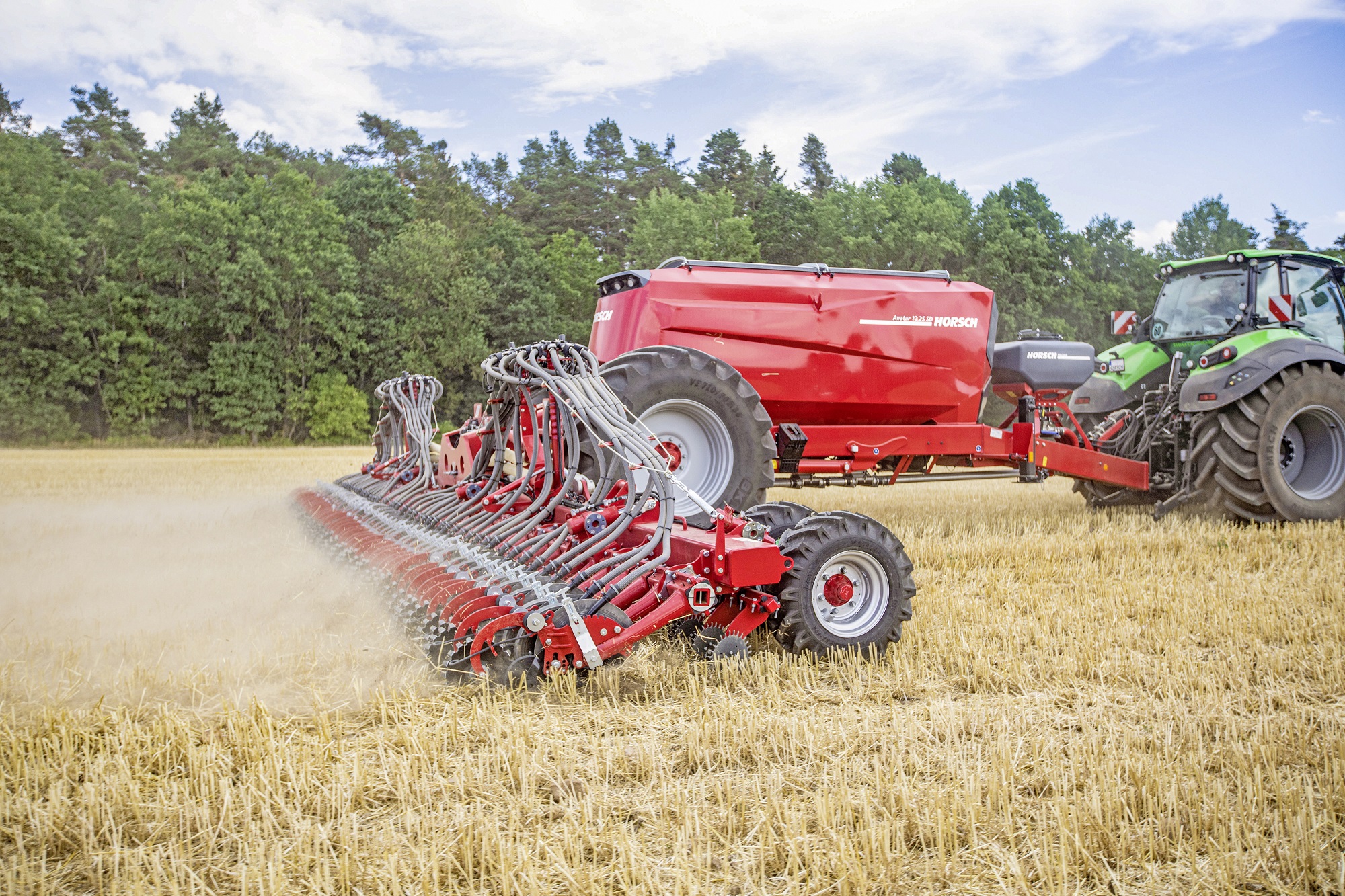
Horsch Avatar 12.25 SD updated with new equipment options
The latest 12m HORSCH Avatar 12.25 SD, launched in early 2022, has been updated with new equipment options, including a new control concept. The intuitive handling system is based on ISOBUS and makes it easier for the farmer to adjust, operate and monitor the drill. The terminal interface can be adapted to the user’s requirements and, with the new hardware and software, HORSCH has created a platform which can supply an almost unlimited number of components when metering.
Thanks to the well-proven folding design the transport dimensions are very compact. With an outside width of 3 metres, it is also ideal for road transport. There are various tyre versions from 520 to 900 tyres and twin tyres.
The newly developed seed hopper platform has a capacity of 6500 litres and can be ordered as a double hopper with a 60:40 ratio. To increase the range further, especially for rape seed, a MiniDrill G&F is now available as an option. This additional hopper has a capacity of 400 litres and is often used for seed, granulates or slug pellets. Filling stops can be reduced and up to 3 components can be metered at the same time.
The seed wagon layout increases the drilling window with the large tyre widths reducing compaction even in wet soil conditions. The double support wheels at the wings ensure low tracks and optimum adaption to the soil. With its 1-row design with SingleDisc coulters and a row spacing of 25cm, the Avatar 12.25 SD is ideal for mechanical population control, but also for the most different sowing methods, such as direct seed, mulch seed and into standing catch crops. The new LED headlight system, WorkLight Pro, allows for driving at night and, like all HORSCH Avatar models, the HM skid as well as the newly developed HM Plus skid provide enormous stability and longevity of the seed coulter.


-

Crop And Carbon: Optimising The Double Yield
Written by Thomas Gent, CEO Agreena UK

It’s no secret that employing regenerative farming techniques – minimal soil disturbance, the use of cover crops and organic manures, applying carbon-rich fertilisers – both reduce the amount of farm-generated greenhouse gas (GHG) emissions and add to the amount of carbon stored in the soil. These GHG reductions and carbon storage initiatives can then be quantified annually, depending on the practices carried out over the harvest year. This, in a nutshell, is what’s referred to as carbon farming.
The quantification of GHG reduction and carbon storage is measured in units called carbon certificates; one certificate represents one tonne of CO2-equivalent emissions (either removed or reduced). If you’re a typical farmer who’s practising carbon farming, you can expect to yield between one and two carbon certificates per hectare per year. But that’s just the beginning. The exciting bit comes when you’re able to optimise and garner a double yield, meaning both crop yield and carbon certificate yield. This is where I’d kindly like to ask you to pause for a moment, take a deep breath and reflect on this perspective:
A carbon certificate yield should be thought of as a crop
yield.Here’s why: Both yields take place once a year in line with the typical summer-tosummer crop cycles we’re all used to. This means you have the potential to harvest two crops from your field: one wheat crop and one carbon crop, for example. Once you’ve harvested your carbon certificates, you need to decide what to do with them. Much like a normal cash crop, they can be kept, used for your own purposes or sold to an end user. You can even work with a company to take them to market for you.
As a farmer myself, I’m constantly researching new and innovative ways to turn my farm into a battleground for combating climate change. Caring for the soil under my feet to sequester carbon from the atmosphere is a profitable and sustainable way to optimise my farm’s carbon negative position while at the same time producing a new asset in the form of a carbon certificate But it isn’t just me; I’ve spoken with many farmers in the area who have recently transitioned to carbon farming through the Agreena certification programme and are now yielding and earning from their carbon harvest.
They’re using Agreena to help them strategise how they can move further away from their established baseline to increase their yield of carbon certificates per hectare – moving more fields over to direct drilling, for instance. Still others have found that crops in the rotation with a high carbon yield, such as pulses and linseed, are inherently less profitable. The carbon payment they’ve received has topped up their profitability and improved their soil.
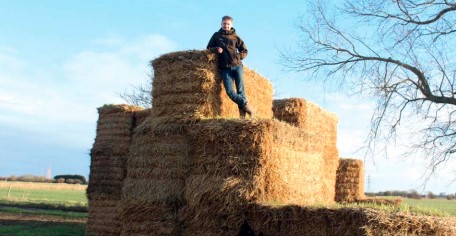
Other key takeaways from these conversations have been that the most ‘carbon yielding’ crops are those that have a cover crop before them. This has helped reduce the need for artificial fertiliser in the cash crop that follows, which can help save big considering the current high price of fertiliser. Planting an over-the-winter crop and following it with a spring cash crop can also generate a lot of carbon certificates and allow you to address problematic, annual winter weeds. This is a win-win for carbon yields and addressing long-standing weed problems.
The Agreena soil carbon platform, aptly named AgreenaCarbon, works to support you in the quantification and planning that’s necessary to begin earning carbon certificates after each annual harvest year. Employed by farmers in 14 countries, the internationally accredited soil carbon certification programme works with world-leading regenerative agriculture technology and external verification partners, so there should be no doubt for corporate buyers and farmers that the programme delivers high-quality carbon certificates. The programme is available to all farms of all sizes and types, and makes a transition to regenerative farming practices financially viable. Perhaps best of all, no matter where you are in your regenerative journey, you can enter the programme.
To learn more about AgreenaCarbon and how you can start optimising your double yield in the field, visit www.agreena.com
-
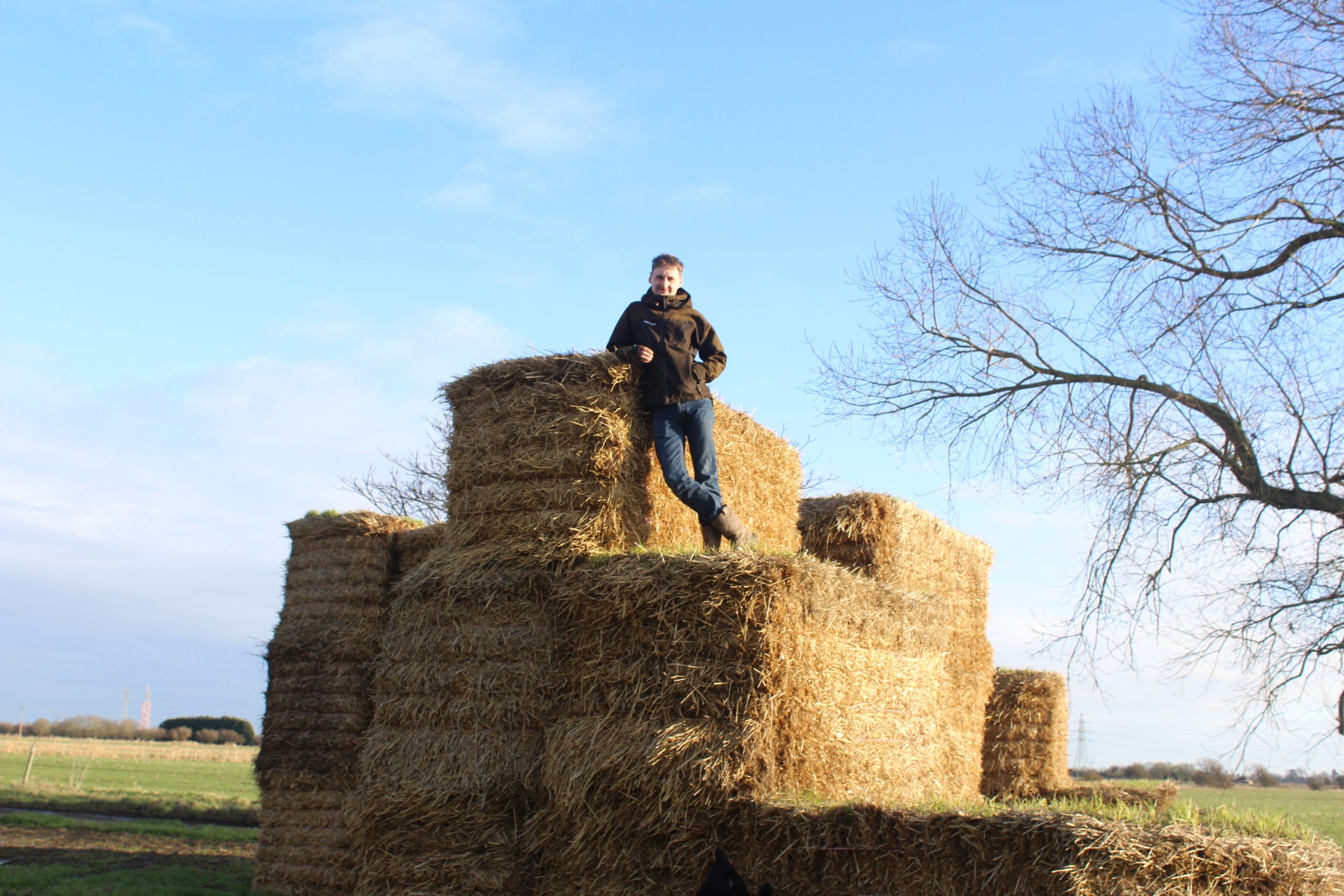
Crop and carbon: Optimising the double yield
Written by Thomas Gent
It’s no secret that employing regenerative farming techniques – minimal soil disturbance, the use of cover crops and organic manures, applying carbon-rich fertilisers – both reduce the amount of farm-generated greenhouse gas (GHG) emissions and add to the amount of carbon stored in the soil. These GHG reductions and carbon storage initiatives can then be quantified annually, depending on the practices carried out over the harvest year. This, in a nutshell, is what’s referred to as carbon farming.
The quantification of GHG reduction and carbon storage is measured in units called carbon certificates; one certificate represents one tonne of CO2-equivalent emissions (either removed or reduced). If you’re a typical farmer who’s practising carbon farming, you can expect to yield between one and two carbon certificates per hectare per year. But that’s just the beginning. The exciting bit comes when you’re able to optimise and garner a double yield, meaning both crop yield and carbon certificate yield. This is where I’d kindly like to ask you to pause for a moment, take a deep breath and reflect on this perspective:
A carbon certificate yield should be thought of as a crop yield.
Here’s why: Both yields take place once a year in line with the typical summer-to-summer crop cycles we’re all used to. This means you have the potential to harvest two crops from your field: one wheat crop and one carbon crop, for example. Once you’ve harvested your carbon certificates, you need to decide what to do with them. Much like a normal cash crop, they can be kept, used for your own purposes or sold to an end user. You can even work with a company to take them to market for you.
As a farmer myself, I’m constantly researching new and innovative ways to turn my farm into a battleground for combating climate change. Caring for the soil under my feet to sequester carbon from the atmosphere is a profitable and sustainable way to optimise my farm’s carbon negative position while at the same time producing a new asset in the form of a carbon certificate But it isn’t just me; I’ve spoken with many farmers in the area who have recently transitioned to carbon farming through the Agreena certification programme and are now yielding and earning from their carbon harvest.
They’re using Agreena to help them strategise how they can move further away from their established baseline to increase their yield of carbon certificates per hectare – moving more fields over to direct drilling, for instance. Still others have found that crops in the rotation with a high carbon yield, such as pulses and linseed, are inherently less profitable. The carbon payment they’ve received has topped up their profitability and improved their soil.
Other key takeaways from these conversations have been that the most ‘carbon yielding’ crops are those that have a cover crop before them. This has helped reduce the need for artificial fertiliser in the cash crop that follows, which can help save big considering the current high price of fertiliser. Planting an over-the-winter crop and following it with a spring cash crop can also generate a lot of carbon certificates and allow you to address problematic, annual winter weeds. This is a win-win for carbon yields and addressing long-standing weed problems.The Agreena soil carbon platform, aptly named AgreenaCarbon, works to support you in the quantification and planning that’s necessary to begin earning carbon certificates after each annual harvest year. Employed by farmers in 14 countries, the internationally accredited soil carbon certification programme works with world-leading regenerative agriculture technology and external verification partners, so there should be no doubt for corporate buyers and farmers that the programme delivers high-quality carbon certificates. The programme is available to all farms of all sizes and types, and makes a transition to regenerative farming practices financially viable. Perhaps best of all, no matter where you are in your regenerative journey, you can enter the programme.
To learn more about AgreenaCarbon and how you can start optimising your double yield in the field, visit www.agreena.com


-

Agronomist In Focus…
RICHARD HARDING

Always start with why…?
Four years ago, John Cherry and I were having an enlightened conversation while seated around his kitchen table discussing the future of agronomy. This was now several years since John and his brother Paul along with Paul’s son Alex, had founded the Groundswell Conference in Hertfordshire. Attending Groundswell, meeting Frederic Thomas, being a BASE member and the other people I have met along the way, have all been defining light bulb moments in my agronomy career. They allowed me to join the dots of mainly subconscious observations made throughout my career and some conscious ones too. I particularly remember one day as a harvest student getting out the tractor cab while waiting for the combine. I noticed the soil in the field under the stubble was loose and friable, it had a sweet smell and good worm activity – a perfect growing medium. Why then were we about to turn this soil upside down in an attempt to recreate the exact same result? That made no sense apart from that’s what everyone does, isn’t it? It felt like this conversation in John’s kitchen was another of these lightbulb moments. We were debating what should the agronomist of the future look like and indeed the type of service they should be offering in a regenerative system?
Fast forward to today and Groundswell Agronomy has enjoyed it’s second year successfully attending the Groundswell Conference 2022. During our conversation in John’s kitchen, I suggested what might appear to be a flawed business model and that was to make myself redundant in ten years. Not because I don’t immensely enjoy what I do, but if one of the overarching principles of the agronomist of the future is to make a regenerative farming system the solution, we have to do things differently. Rather than the current model of an in season, short term solution from a can focusing on margin over input costs. We know intuitively that we need to take a far more long-term view. Taking inspiration from organic systems or any system for that matter, where nutrition is considered rotationally rather than crop specifically.
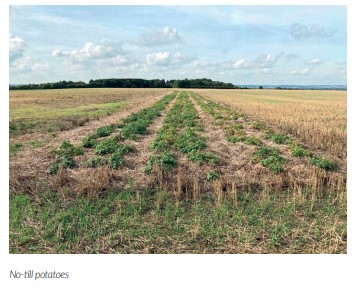
Regenerative farming is nothing new, when you interrogate the principles of such a system, they are what good mixed farming has always been about albeit with a better understanding of the “why” something works. Our understanding of soil biology is just one example of an area that during my studies was barely mentioned. Today we are aware of its importance and seek to understand it in far more detail than ever before.
Over the last year we have seen huge volatility in input and energy prices which makes one of the key drivers behind my interest in a conservation or regenerative model so important, and that has always been to future proof the rural farm business (acknowledging most farm businesses are very diversified), maximise the return on investment and the management time employed. One challenge that a regenerative system currently faces and one that is having an increasing effect on the practical agronomy of these crops, is a consistency of core values. Regulation brings a degree of structure missing from regenerative agriculture at the moment. While I’m definitely not a fan of highly regulated industries having a framework to work within would bring credibility for the system and clarity to the consumer. There are fundamental principles that are well accepted within a regenerative system however these are interpreted slightly differently, depending on the individual’s interpretation of these principles and depending on their world view. Their attitude to risk, the time of the year and most definitely this year, changes in grain prices all derail the best of intentions.
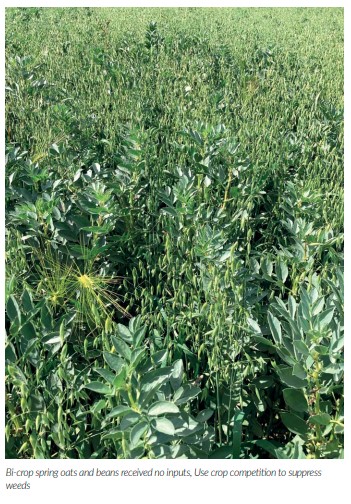
Which means that communication between the grower and the agronomist becomes ever more important. I often joke about the need for farmers and agronomists to have couples therapy, but it is vital for everyone involved in growing the crop to have a clear understanding of the overall objectives, the businesses attitude to risk and the fundamental “why” behind the decision making. Why is such a powerful word and it’s not until we ask ourselves why at least four times can we rarely get to the reality of why we’re thinking and feeling a certain way. While we are skilled at crafting a rational justification for what we do. The reality can be sometimes quite different.
In trying to answer the question “is there another way” to farm. It has led me to question every decision we make as agronomists. As I researched further seeking to properly understand soils and how to manage them, I moved from thinking things were simple to very complex before realising what seemed complex was actually very simple. However, the key when working more closely with natural systems is to always have a plan B, C, D and E. Irrespective of farm size this is very possible, but it requires a very different way of thinking and being flexible and open to change. An example of this, and one that may seem extreme is that if we accept as farmers, we are ultimately trying to farm sunlight and if we’re to manage soils better, permanent soil cover is a fundamental goal of the system. Then when we plant something, we don’t necessarily know whether that crop will be a cash crop, a forage crop or a cover crop? We are used to controlling nature and I suggest we can learn more by taking inspiration from nature to create a truly efficient system.
All the while being aware as humans, we are very good at self-sabotage. We need to be aware of the cycle of SELF-SABOTAGE and be compassionate when we fall victim to this process particularly when we are trying to adopt a new system or approach. We favour doing what feels comfortable – we then decide to make a change – we take steps to change – the change feels good – this feels different – we feel uncomfortable – we question the changes made – our subconscious craves familiarity, and the cycle begins again. While it’s easy to explain a concept by going to extremes and to some a regenerative system can seem extreme, if it does nothing else but to make you stop and question your approach there is a value in that alone. There are always aspects of the system which can provide benefit and fit into a more conventional approach.
To find better ways of doing things to some extent ignoring labels can be helpful and shifting the focus on the value of each individual technique being deployed. One thing that is clear from other parts of the world is in order to make an alternative system work well it involves far more trusting and intimate relationships with the rest of the supply chain. Only by challenging convention throughout the supply chain will we achieve success. We need to reimagine everything from the soil up.
So, while having these grand aspirations is all very well, what does that look like day to day in the field and where could farmers trials, as well as more formalised trials start investigating? Here are a few conversation starters to have with your agronomist the next time you have your therapy session together!
1.Alongside trials, one starting point is to begin with knowledge exchange and financial benchmarking peer to peer, facilitated by the agronomist is essential first step. Many growers would be dismissive of the concept of no-till potatoes as unrealistic but such projects while extreme are a way to interrogate a different way of thinking. We need to ask what elements of this approach could have value whatever the system?
2.Where does your advice come from? Maybe growers should swap their agronomist every three years to maintain innovation? This was an idea suggested by Mark Dewes at a panel discussion at Groundswell in 2021. Mark had recently completed a Nuffield Scholarship into looking at different agronomy models around the world.
3.Our cover crop knowledge is very much in its infancy, and everyone is trying to achieve different things. The starting point is to know the value of the benefit you are getting from that particular cover crop. Aiming to ideally make every cover crop a cash crop. Relay cover cropping and blurring the line overlapping a cash and a cover crop can be a more nuanced way of getting the best return on investment from that cover crop. Quantifying the true value cover crops bring to improving nutrient use efficiency would give more confidence in using cover crops more widely.
4.Maintain a balance; as farmers we love the production element of growing but maintaining a balance accepting for a regenerative system to work our attention needs to be focused, 50% on marketing and 50% on growing in that order and irrespective of whether the product leaves the farm as a 29ton bulk lorry or a single branded 500g bag. The best example of farmers making the system work around the world is through diversity of crop and market. It may be a contentious question, but why exactly in a more normalised year are we growing so much wheat, while historically farm profitability has been declining for some?
5. Is our idea of efficiency flawed – a question for another day but something to ponder?

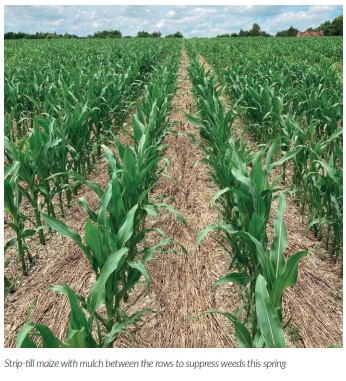
Lastly, an interesting question. Why is it that Microsoft is reportedly the second-largest employer of anthropologists in the world? In essence it can be summed up by the fact that in order to know where were going we must first know where we have come from. There is nothing new in farming or farming regeneratively just the way we think and join the dots. richard@groundswellag.com
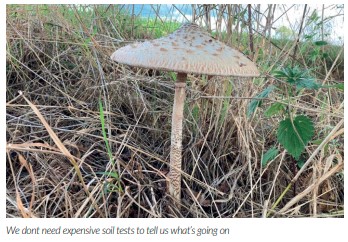
-
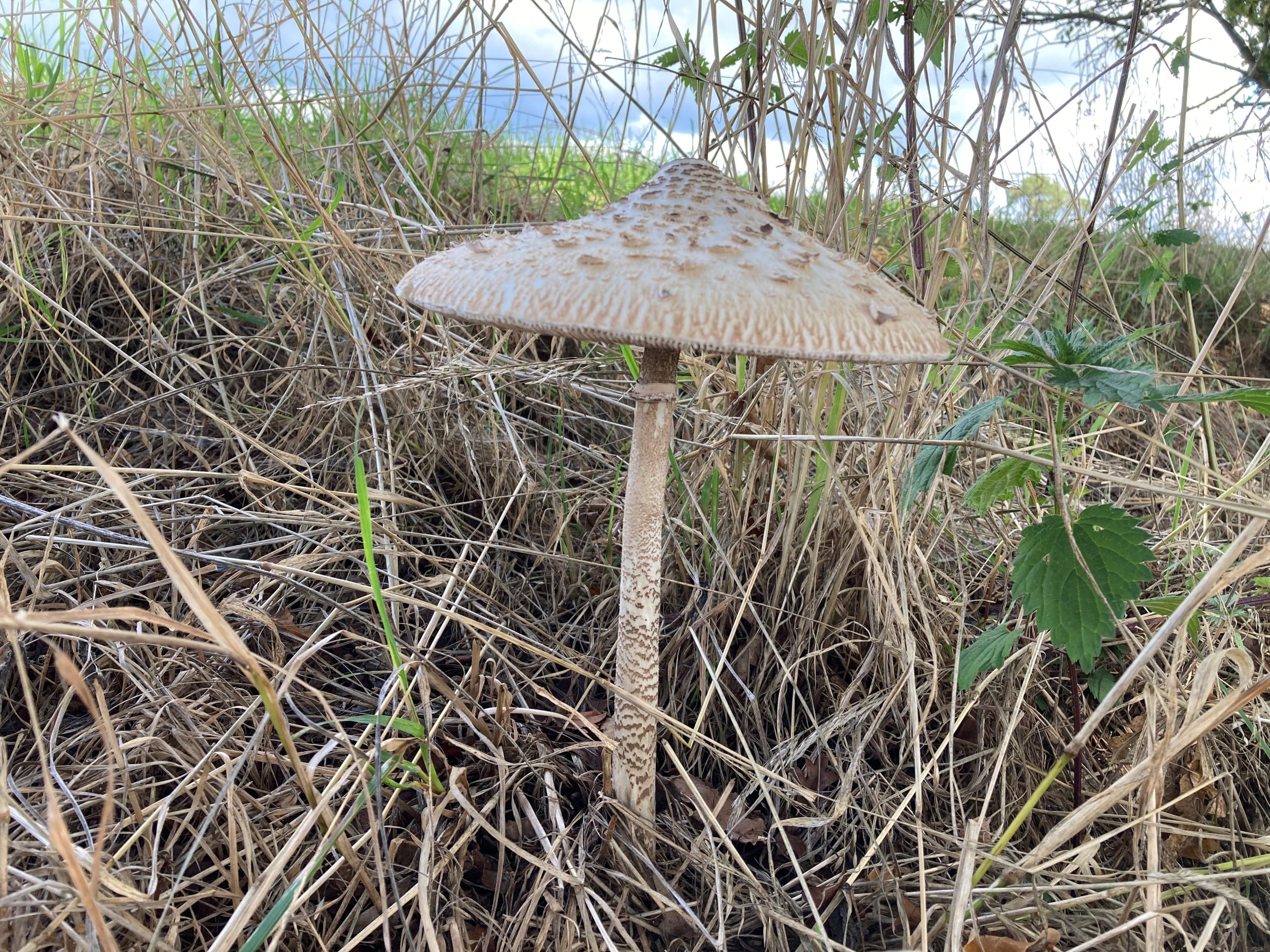
Agronomist in Focus – Richard Harding
Always start with why…?
Four years ago, John Cherry and I were having an enlightened conversation while seated around his kitchen table discussing the future of agronomy. This was several years after John and his brother Paul along with Paul’s son Alex, had founded the Groundswell Conference in Hertfordshire.
Attending Groundswell, meeting Frederic Thomas, being a BASE member and the people I have met along the way, have all been defining light bulb moments in my agronomy career. They allowed me to join the dots of mainly subconscious observations made throughout my career and some conscious ones too. I particularly remember one day as a harvest student getting out the tractor cab while waiting for the combine. I noticed the soil in the field under the stubble was loose and friable, it had a sweet smell and good worm activity – a perfect growing medium. Why then were we about to turn this soil upside down in an attempt to recreate the exact same result? That made no sense apart from that’s what everyone does, isn’t it? It felt like this conversation in John’s kitchen was another of these lightbulb moments. We were debating what should the agronomist of the future should look like and importantly, what type of service they should be offering in a regenerative farming system?
Inspiration from organic systems
Fast forward to today and Groundswell Agronomy has enjoyed it’s second year successfully attending the Groundswell Conference 2022. During our conversation in John’s kitchen, I suggested what might appear to be a flawed business model and that was to make myself redundant in ten years. Not because I don’t immensely enjoy what I do, but if one of the overarching principles of the agronomist of the future is to make a regenerative farming system the solution, we have to do things differently, Rather than the current model of an in season, short term solution from a can focusing on margin over input costs. We know intuitively that we need to take a far more long-term view. Taking inspiration from organic systems or any system for that matter, where nutrition is considered rotationally rather than crop specifically.
Regenerative farming is nothing new, when you interrogate the principles of such a system, they are what good mixed farming has always been about albeit with a better understanding of the “why” something works. Our understanding of soil biology is just one example of an area that during my studies was barely mentioned. Today we are aware of its importance and seek to understand it in far more detail than ever before.
Over the last year we have seen huge volatility in input and energy prices which makes one of the key drivers behind my interest in a conservation or regenerative model so important, and that has always been to future proof the rural farm business (acknowledging most farm businesses are very diversified), maximise the return on investment and the management time employed. One challenge that a regenerative system currently faces and one that is having an increasing effect on the practical agronomy of these crops, is a consistency of core values. Regulation brings a degree of structure missing from regenerative agriculture at the moment. While I’m definitely not a fan of highly regulated industries having a framework to work within would bring credibility for the system and clarity to the consumer. There are fundamental principles that are well accepted within a regenerative system however these are interpreted slightly differently, depending on the individual’s interpretation of these principles and depending on their world view. Their attitude to risk, the time of the year and most definitely this year, changes in grain prices all derail the best of intentions.

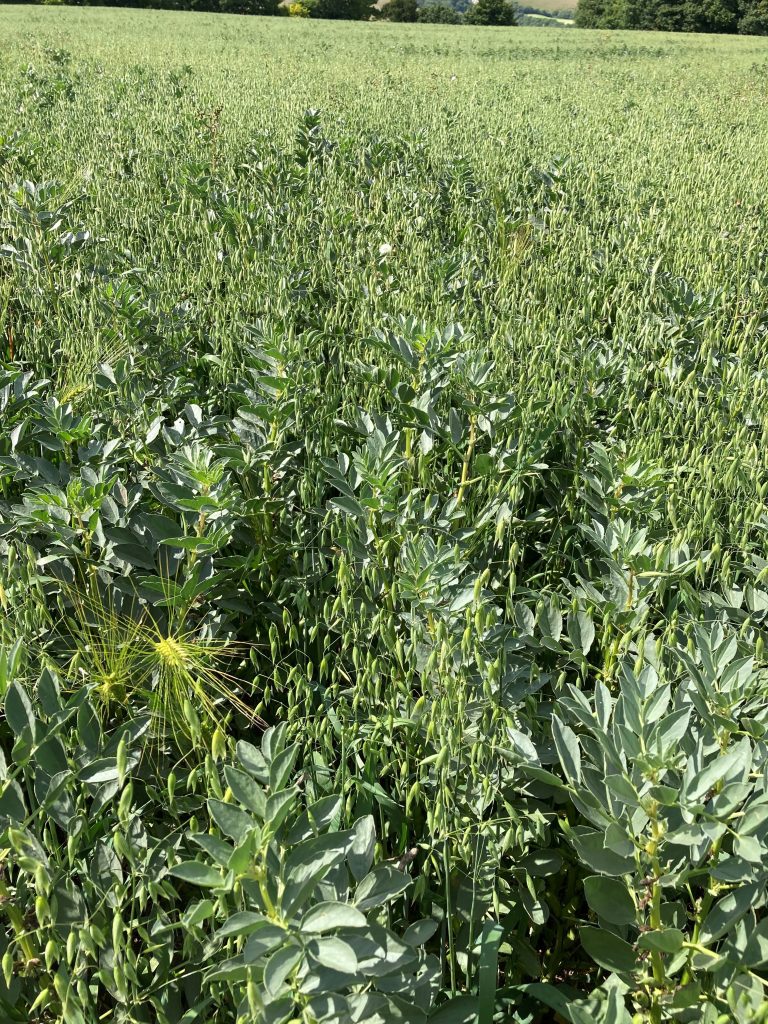
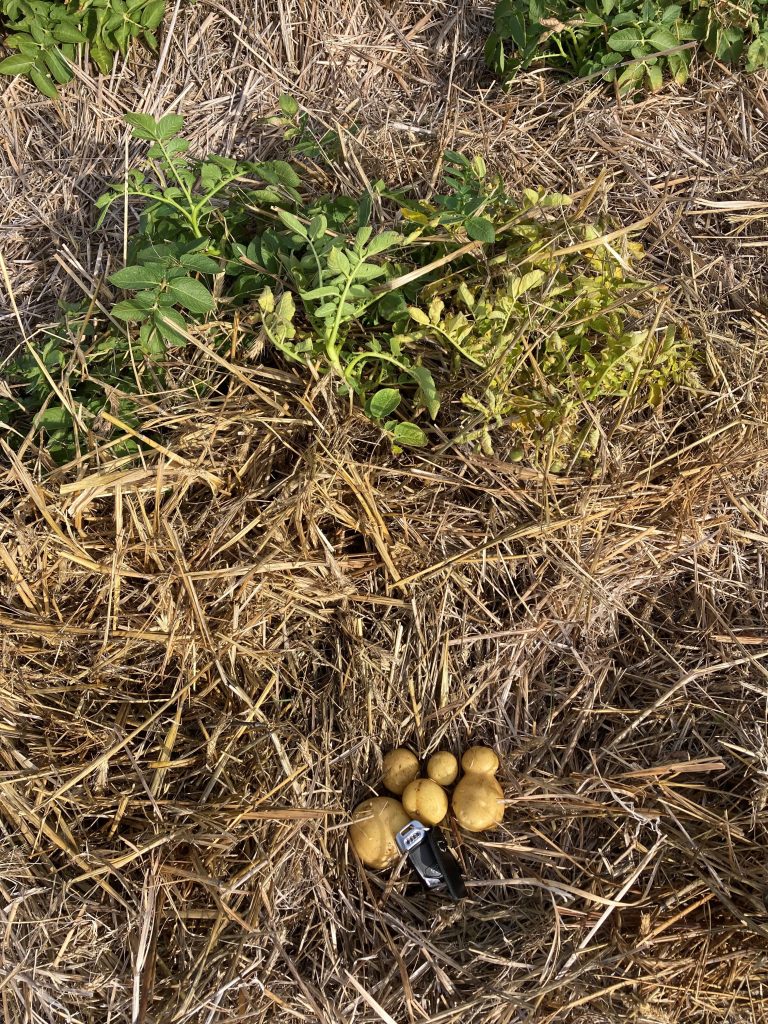
The key to working closely with natural systems
Which means that communication between the grower and the agronomist becomes ever more important. I often joke about the need for farmers and agronomists to have couples therapy, but it is vital for everyone involved in growing the crop to have a clear understanding of the overall objectives, the businesses attitude to risk and the fundamental “why” behind the decision making. Why is such a powerful word and it’s not until we ask ourselves why at least four times can we rarely get to the reality of why we’re thinking and feeling a certain way. While we are skilled at crafting a rational justification for what we do. The reality can be sometimes quite different.
In trying to answer the question “is there another way” to farm. It has led me to question every decision we make as agronomists. As I researched further seeking to properly understand soils and how to manage them, I moved from thinking things were simple to very complex before realising what seemed complex was actually very simple. However, the key when working more closely with natural systems is to always have a plan B, C, D and E. Irrespective of farm size this is very possible, but it requires a very different way of thinking and being flexible and open to change. An example of this, and one that may seem extreme, is that if we accept that, as farmers, we are ultimately trying to farm sunlight and so if we’re to manage soils better, permanent soil cover is a fundamental goal of the system. Then when we plant something, we don’t necessarily know whether that crop will be a cash crop, a forage crop or a cover crop? We are used to controlling nature and I suggest we can learn more by taking inspiration from nature to create a truly efficient system.
Question your approach to farm management
All the while being aware as humans, we are very good at self-sabotage. We need to be aware of the cycle of SELF-SABOTAGE and be compassionate when we fall victim to this process particularly when we are trying to adopt a new system or approach. We favour doing what feels comfortable – we then decide to make a change – we take steps to change – the change feels good – this feels different – we feel uncomfortable – we question the changes made – our subconscious craves familiarity, and the cycle begins again.
While it’s easy to explain a concept by going to extremes and to some a regenerative system can seem extreme, if it does nothing else but to make you stop and question your approach there is a value in that alone. There are always aspects of the system which can provide benefit and fit into a more conventional approach.

No-till potatoes To find better ways of doing things to some extent ignoring labels can be helpful and shifting the focus on the value of each individual technique being deployed. One thing that is clear from other parts of the world is in order to make an alternative system work well it involves far more trusting and intimate relationships with the rest of the supply chain. Only by challenging convention throughout the supply chain will we achieve success. We need to re-imagine everything from the soil up.
So, while having these grand aspirations is all very well, what does that look like day to day in the field and where could farmers trials, as well as more formalised trials start investigating? Here are a few conversation starters to have with your agronomist the next time you have your therapy session together!
• Alongside trials, one starting point is to begin with knowledge exchange and financial benchmarking peer to peer, facilitated by the agronomist is essential first step. Many growers would be dismissive of the concept of no-till potatoes as unrealistic but such projects while extreme are a way to interrogate a different way of thinking. We need to ask what elements of this approach could have value whatever the system?
• Where does your advice come from? Maybe growers should swap their agronomist every three years to maintain innovation? This was an idea suggested by Mark Dewes at a panel discussion at Groundswell in 2021. Mark had recently completed a Nuffield Scholarship into looking at different agronomy models around the world.
• Our cover crop knowledge is very much in its infancy, and everyone is trying to achieve different things. The starting point is to know the value of the benefit you are getting from that particular cover crop. Aiming to ideally make every cover crop a cash crop. Relay cover cropping and blurring the line overlapping a cash and a cover crop can be a more nuanced way of getting the best return on investment from that cover crop. Quantifying the true value cover crops bring to improving nutrient use efficiency would give more confidence in using cover crops more widely.
• Maintain a balance; as farmers we love the production element of growing but maintaining a balance accepting for a regenerative system to work our attention needs to be focused, 50% on marketing and 50% on growing in that order and irrespective of whether the product leaves the farm as a 29ton bulk lorry or a single branded 500g bag. The best example of farmers making the system work around the world is through diversity of crop and market. It may be a contentious question, buy why exactly in a more normalised year are we growing so much wheat, while historically farm profitability has been declining for some?
• Is our idea of efficiency flawed – a question for another day but something to ponder?
Lastly, an interesting question. Why is it that Microsoft is reportedly the second-largest employer of anthropologists in the world? In essence it can be summed up by the fact that in order to know where were going we must first know where we have come from. There is nothing new in farming or farming regeneratively just the way we think and join the dots.
richard@groundswellag.com





-

Drill Manufacturers In Focus…
EXCELLENT RESULTS FROM THE 2022 HARVEST, BUT WHAT NEXT?

With the harvest safely gathered in Jeff Claydon, Suffolk arable farmer and inventor of the Opti-Till® direct strip seeding system, discusses the results and looks ahead to next season.
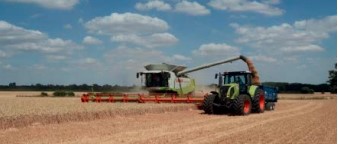
18 August 2022
It has been a very strange year for weather in most parts of the UK. Here in Suffolk, where annual rainfall is just 600mm making it one of the driest regions, the exceptional conditions brought back memories of 1976. That year, almost no rain fell between March and September and during a visit to the county then Minister of Agriculture, the late Fred Peart, described the drought as a tragedy, urging the public not to panic. Sounds familiar! Between New Year’s day and the end of May this year our farm weather station recorded 196.8mm of rain, well below the long-term average. April brought only 18.6mm and in May 41.6mm fell, followed by 34.4mm in June and a miniscule 10.4mm in July, contributing to a total of just 244mm for the year to date. Much of that came in the form of short, localised showers, so the water evaporated very quickly and produced little benefit.
One positive of the exceptionally dry conditions was our earliest-ever harvest. The 12m Claas Lexion 600 Terra-Trac had an uninterrupted run from the time we cut the first oilseed rape in mid-July until the last spring oats which were combined during the first week of August. With daytime temperatures consistently in the mid-to-high 30s and little in the way of overnight dew we were able keep going for as long as we were physical able to do so. It was a very tiring couple of weeks, but with help from my sons, Oliver and Spencer, harvest was completed in record time and with wheat coming into store at 11-12% there were no drying costs.
Too dry to drill
The downside of the prolonged dry weather is that currently the land is too dry to drill oilseed rape. Normally, the crop would have been in the ground a week or two ago but, with no moisture to start the germination process, drilling it then would have been a mistake. Patience is the key as we await some meaningful rain! The ground is so dry and cracked that undertaking any form of conventional cultivations would be very expensive in fuel, excess wear on machinery and ground-engaging metal. Breaking down the large clods created by that approach would also be very time-consuming and expensive but driving around the area those drawbacks have not stopped some from trying. On our own heavy clay land, the Claydon Straw Harrow has been successfully deployed across the whole farm, the main limitation being keeping dust to a minimum by restricting forward speed when operating close to houses in the village, especially if they have washing on the line!
With our rotation having changed from wheat and oilseed rape to include more spring-sown and break crops, the aim is to use land destined for spring drilling to help reduce the weed burden and seed bank using Opti-Till® stubble management techniques which move no more than 2cm of topsoil. This enables us to control weed seeds and volunteers without herbicides, other than one full-rate application of glyphosate just prior to drilling. Effective stubble management has become particularly important following the loss of neonicotinoid seed treatments and some products to control grassweeds due to the inherent fear that the aphid vectors of Barley Yellow Dwarf Virus (BYDV) will increase significantly. However, BYVD can be reduced considerably by using the Opti-Till® system to manage stubbles and eliminate the ‘green bridge’ effect. It also enables drilling to be delayed, but to do that with any degree of certainty you must be able to get the crop in the ground quickly, which means not having too many operations before sowing.
Last night’s 2.4mm of rain was just enough to make conditions perfect for the Claydon Straw Harrow, a simple, robust, fast, and very effective stubble management tool with many uses. Operating at 15 – 25km/h, it is equipped with sprung steel tines which vibrate rapidly to break up straw and expose chopped crop residues. They also create a ‘boiling’ action which uproots weeds and volunteers, as well as destroying slugs and slug eggs. An additional upside of the hot, dry conditions has been that slugs have had a very tough time and have been unable to breed, so we will not have to worry about them this season.
The Straw Harrow creates a fine micro-tilth in the top 20- 30mm of soil, providing ideal conditions for rapid germination of weeds and volunteers, which can then be raked out and destroyed with another pass before they become established. When glyphosate is eventually applied, it is as a single, full strength dose prior to drilling, which maximises its effectiveness and reduces the risk of weed resistance Even during a prolonged dry spell and high summer temperatures the difference between harrowed and unharrowed soil is clear. Unharrowed soil is hard and baked with shrinkage cracks; soil that has been harrowed has a crumbly, fine tilth and crop residues have been broken into small pieces.
20-Year Anniversary
This harvest marked 20 years of establishing all crops on the farm using only Claydon Opti-Till® products. These consist of the Straw Harrow, occasionally the TerraStar® light rotary cultivator where slightly more soil movement is required, together with the Claydon direct strip seeding drill, followed by the TerraBlade inter-row hoe. My last article for Direct Driller mentioned that our crops were showing exciting potential, and they certainly lived up to expectations. That was a pleasant surprise given the lack of rain and the fact that we backed off on the nitrogen due to concerns that it would not be fully utilised in the dry conditions. This was a good decision, made easier because we only grow feed wheats. Winter wheats received 190kgN/ha, 50 – 60kgN/ ha less than our normal 240-250kgN/ha, and oilseed rape a similar amount, again less than normal.
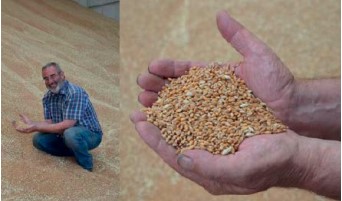
In a couple of small areas where nitrogen was missed when applying it through our 36m self-propelled sprayer, for which I can only blame myself, the yield plummeted, highlighting the importance of this major nutrient. Without fertiliser and agchems yields would quickly regress to 1970s levels, around 30cwt for barley and 2 tons per acre in ‘old money’ terms, or 3.7t/ha and 5t/ha respective in modern parlance. The key difference between the 1970s and now is that there are more mouths to feed. According to the Office of National Statistics the UK population was 56,226,000 in 1975, it rose to 65,110,000 in 2015 and is projected to hit 69,444,000 by 2025. Should we therefore be concerned about the dramatic curbs on nitrogen use currently being proposed by the governments of The Netherlands and Canada?
Fungicide programmes were maintained at normal levels because these products more than cover their cost through increased yield. Past experience has shown that if yellow rust or other foliar diseases take hold significant yield potential has already been lost by the time the signs become visible, far outweighing the cost of an effective treatment programme..
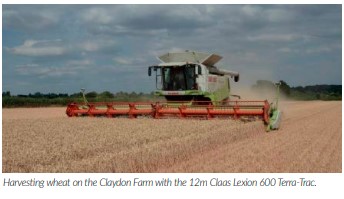
Good drainage increases yields
Drainage is very important to get the best from our heavy clay soils and in a couple of areas where the old tile system had broken down a significant reduction in yield was apparent. One 12ha area produced 7.78t/ha, compared with over 9.5t/ha in the adjacent field, an overall loss across that small area of around 25 tonnes, so correcting the problem was a priority. Dry weather allowed local drainage contractor W. R. Suckling & Sons to install new plastic pipes 1m deep across a total of 40ha in various fields. Some was done in the spring, some through rape stubble, and we will mole drain across these areas when conditions allow. Land is far too valuable to have it underperform, and this investment should maximise its potential by increasing yields.
The dry spring and summer, combined with the use of a Claydon TerraBlade inter-row hoe meant that our crops were the cleanest I have ever known, with no spring-germinated blackgrass. I am delighted with the results of the 2022 harvest, high yields underlining the benefits of establishing deep rooting structures which enabled crops to make best use of available moisture. Having recently invested in a new weighbridge we know that the yield information is precise and have posted it on the Claydon website (claydondrill.com). Those of you who have visited the Claydon factory will know the 16ha field to the right of the access road. The winter wheat there yielded just over 10t/ha, while the average across our whole IACA registered area was 9.54t/ha, with higher-thanaverage hectolitre weights. Given the lack of rain and 25% reduction in nitrogen use those are both excellent figures.

Hybrid oilseed rape provided a similarly pleasing result. DK Excited, which was drilled at just 2.7kg/ha using a preproduction version of our new Claydon Evolution drill, averaged 3.84t/ha, with one field producing 4.2t/ha. Given that the crop had to contend with very dry weather, some pigeon damage, and small areas where cabbage stem flea beetle had attacked, these yields are exceptional. With very low establishment costs, a low level of fungicide use, and just 190kgN/ha the margin will be very attractive. Spring oats put in a surprising performance and are destined for use in a range of gluten-free products such as breakfast cereals and oat milk. We drilled the new Elsoms variety Lion directly into stubble which had been Straw Harrowed using a seed rate of just 100kg/ha and the crop subsequently received a total of 100kgN/ha in two equal splits.
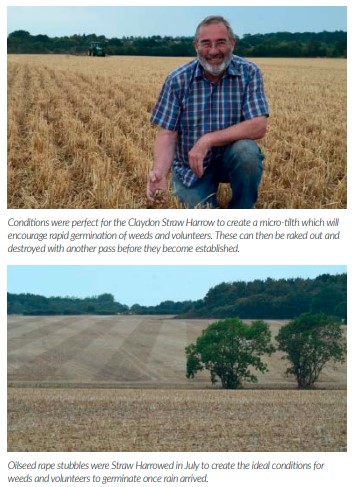
A Claydon TerraBlade inter-row hoe took out any grassweeds growing between the band-sown rows before they had a chance to develop and compete with the spring oats, so the crop looked clean throughout. Given the season’s challenges I was very pleased that it averaged 6.11t/ha, which was slightly below the 7t/ha from last year’s crop of WPB Elyann (KWS) but that had much more favourable growing conditions. We will be drilling Lion again in 2023, as 25% of the farm will be into spring oats, 25% oilseed rape and 50% winter wheat, all first wheats.

Current conditions are the polar opposite of those last year, when there was plenty of moisture in the ground during August, but September was quite dry. With the ground currently bone dry we are waiting for significant rainfall to provide some moisture, so everything is currently in a state of limbo. The soil temperature is much higher than at the same time last year, so I am not too concerned that oilseed rape has not been drilled; it is much better to wait and sow into moisture than have the seed sit there doing nothing. Our own land is showing none of the deep cracking which is evident on some nearby farms where conventional cultivations and establishment protocols are used, nor do we have deep tramlines which will take time and money to put right. In contrast, our, fields are level with a layer of fine tilth and crop residues on the surface which will protect and insulate the soil, providing perfect conditions for drilling when we do get some rain.

With Claydon customers saving up to £250/ha on establishment costs by using the Opti-Till® System demand for our products from farmers throughout the world is at record levels, so I am delighted that our new 36m x 36m clear-span building is almost finished. We have managed the build project in-house but, due to difficulties in getting contractors, progress has been slower than anticipated. The concern now is finding enough additional staff to fill the numerous vacancies that we have to offer so if you know of anyone who might be interested in a role please ask them to contact us! When complete the new facility will double our production capacity.
Just before harvest, accredited master thatcher Harry Roberts of Harry Roberts Thatching Services finished replacing the roof at Gaines Hall, our Grade II listed 16th Century farmhouse. After 44 years’ service it was rethatched using wheat straw grown by Harry using the heritage wheat variety Maris Widgeon, drilled using a Claydon drill. We are delighted with the results.
-
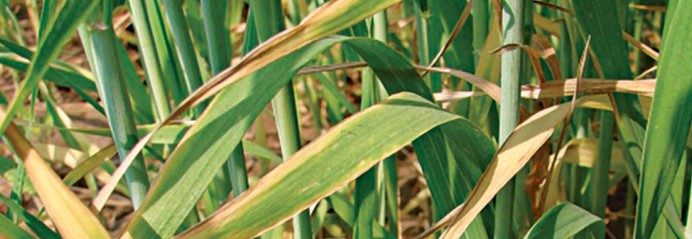
Robert Plumb Discusses Biological Farming
BIOLOGICAL Farming, with the help of natural soil bacteria and Fungi, is growing rapidly and in the current crazy
climate there is more and more interest – after all, we can now use these little bugs to provide Nitrogen, Phosphate
and now Potassium. There are also products that will stimulate root growth and help to reduce disease pressure.
Written by Robert Plumb
I have been working on the Biological side of farming for 20+ years; before that, I was a fertiliser blender in mainstream agriculture, so over the years I have seen a few changes, not least the demise of companies like ICI, Fisons, Albright &Wilson and lots of others. In those early days when fertilisers were made more commonly available, many fertiliser companies took soil samples and simply recommended their products. It was very confusing for farmers as the soil results given used a range of different laboratories many using different extraction methods, this meant the farmer could not easily compare results.
In the early 70’s the ADAS (then based at Cambridge), asked for a meeting with these fertiliser companies that included ICI, Fisons (now Norsk Hydro) and about15 other companies plus advisors; they then worked on an extraction method for a common soil analysis.
Now bear in mind these people were there to sell fertiliser. The idea of replacing what you take off came later and sounds very good but is it really necessary? Little notice was made for the use of manure, and compost was unheard of. At that time fertilisers were quite cheap and a rule of thumb was a tonne of Nitrogen was about the same price as a tonne of Wheat, ie about £20.In fact, most compounds were at a similar price and Phosphate even qualified for a subsidy, as did all lime materials. It was a pretty simple system and it certainly sold a lot of fertiliser. But was it really necessary? Many of our long term friends have not applied any P or K fertilisers – other than a bit of compost, for a very long time (20 years plus) and their soil levels are pretty much the same as when we started, and yields have been OK. They are not trying to grow maximum yields but do they actually make a profit?
Levels of K go from low to high
Potassium (K) is extremely important for crop health and yield and at Soil Fertility Services we like to monitor the plant response with regular plant samples. We found that last season’s K levels – in all crops, were extremely low. No surprise from a dry soil. With plants unable to pull it off the clay particles and exchange sites, we are now being told that straw K levels were high! Potassium is important as it helps a plant to regulate water uptake and the opening and closing of the stomata; it is also critical in producing proteins and most wheat protein levels have been low.
Plants actually need similar amounts of Potassium as they do Nitrogen. This could be up to 200kg. I have never seen one with that level of Potassium at the main stem extension period, but now we may be able to help. We have developed a K fixing product. Similar to the N Fixing product Bio-N, the beneficial K fixing micro-organisms will release around 50kg of K from your soil’s “locked” up reserves, directly into the rhizosphere where your plant system can easily take it up. It may take two applications of 10 litres to provide all your crop’s needs, but it will surely help to overcome the problem of Potassium shortages.
We have been measuring ‘total Soil K reserves’ and find between 6,000 and10,000 kg/ha in the top 10cm (4”) of your soil. Most of this K is in the lattice of the clay particles and is considered ‘unavailable’, but we can easily find200 – 300 kg on the surface of the clay fraction that can be made available to your crop with the help of the Bio-K.
-

Robert Plumb Discusses Biological Farming
BIOLOGICAL Farming, with the help of natural soil bacteria and Fungi, is growing rapidly and in the current crazy climate there is more and more interest – after all, we can now use these little bugs to provide Nitrogen, Phosphate and now Potassium. There are also products that will stimulate root growth and help to reduce disease pressure.
I have been working on the Biological side of farming for 20+ years; before that, I was a fertiliser blender in mainstream agriculture, so over the years I have seen a few changes, not least the Demise of companies like ICI, Fisons, Albright & Wilson and lots of others.
In those early days when fertilisers were made more commonly available, many fertiliser companies took soil samples and simply recommended their products. It was very confusing for farmers as the soil results given used a range of different laboratories many using different extraction methods. This meant the farmer could not easily compare results.
In the early 70’s the ADAS (then based at Cambridge), asked for a meeting with these fertiliser companies that included ICI, Fisons (now Norsk Hydro) and about 15 other companies plus advisors; they then worked on an extraction method for a common soil analysis.
Now bear in mind these people were there to sell fertiliser. The idea of replacing what you take off came later and sounds very good but is it really necessary? Little notice was made for the use of manure, and compost was unheard of. At that time fertilisers were quite cheap and a rule of thumb was a tonne of Nitrogen was about the same price as a tonne of Wheat, ie about £20. In fact, most compounds were at a similar price and Phosphate even qualified for a subsidy, as did all lime materials.
It was a pretty simple system and it certainly sold a lot of fertiliser. But was it really necessary? Many of our long-term friends have not applied any P or K fertilisers – other than a bit of compost, for a very long time (20 years plus) and their soil levels are pretty much the same as when we started, and yields have been OK. They are not trying to grow maximum yields but do they actually make a profit?
Potassium (K) is extremely important for crop health and yield and at Soil Fertility Services we like to monitor the plant response with regular plant samples. We found that last season’s K levels – in all crops, were extremely low. No surprise from a dry soil. With plants unable to pull it off the clay particles and exchange sites, we are now being told that straw K levels were high! Potassium is important as it helps a plant to regulate water uptake and the opening and closing of the stomata; it is also critical in producing proteins and most wheat protein levels have been low.
Plants actually need similar amounts of Potassium as they do Nitrogen. This could be up to 200kg. I have never seen one with that level of Potassium at the main stem extension period, but now we may be able to help.
We have developed a K fixing product. Similar to the N Fixing product Bio-N, the beneficial K fixing micro-organisms will release around 50kg of K from your soil’s “locked” up reserves, directly into the rhizosphere where your plant system can easily take it up.
It may take two applications of 10 litres to provide all your crop’s needs, but it will surely help to overcome the problem of Potassium shortages.W e have been measuring ‘total Soil K reserves’ and find between 6,000 and 10,000 kg/ha in the top 10cm (4”) of your soil. Most of this K is in the lattice of the clay particles and is considered ‘unavailable’, but we can easily find 200 – 300 kg on the surface of the clay fraction that can be made available to your crop with the help of the Bio-K.



-
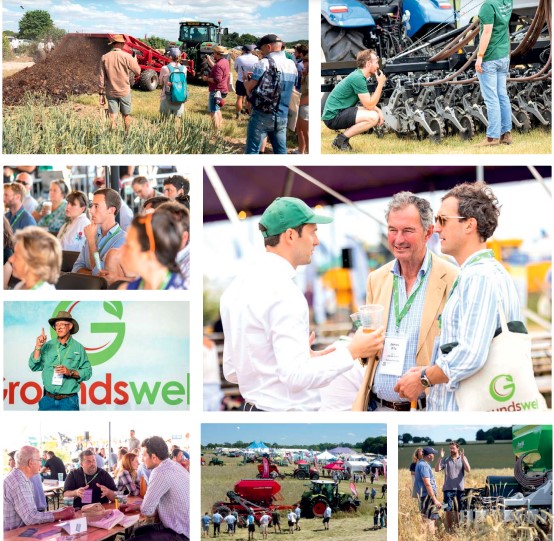
Groundswell 2022
Farmers and growers flocked to the sixth annual Groundswell, the UK’s largest regenerative agricultural show in late
June this year. It was another sell-out event with 5,500 attendees who travelled to North Hertfordshire for two days of
information exchange, inspiration and a bit of liquid refreshment during the worst drought since 1976.Written by Alex Cherry
With over 140 sessions to attend, Groundswell offered a platform for household names, technical experts, experienced regenerative farmers and leading researchers to explore and debate the issues, opportunities, science and practices around regenerative agriculture. The event has grown from 500 farmers in a barn in 2016 as the “No-Till Show” to the two-day “Regenerative Agriculture Show and Conference” that it is today. Although, one commentator referred to it as a “Festival of Ideas” which perhaps seems more appropriate given the scale and breadth of content.
The eve before Groundswell is always exciting as people begin to arrive from all corners of the UK and beyond, pitching tents and getting the lay of the land. It is a chance to catch up with old friends and make new acquaintances in The Earthworm Arms Bar, where there were some enticing foodie offerings including different Pasture for Life meats cooked over fire. Dr Doolittle took to the decks and blasted out some disco classics which had mixed reviews from the audience, although a loyal cohort in Hawaiian shirts kept the energy going. The camping area soon filled up with around 750 campers with all shapes and sizes of tents and campervans.
On Wednesday morning Jill Clapperton kicked off proceedings in the Big Top tent, followed by Greg Judy advising farmers “How to think like a Grazier”. Across the8 different session venues it was tough deciding what to go and see. Before the midday session a tribute was made to Caroline Drummond MBE, recognising her incredible achievements of 30 years leading LEAF, before her tragic passing in May.
Henry Dimbleby provided a one year update to the National Food Strategy and Dwayne Beck from South Dakota asked “Are We Doing The “Right Things” Or Only Doing The Wrong Things Better? ”Billy Lewis was announced as “Mixed Soil Farmer of the Year” and David Miller as the “Arable Soil Farmer of the Year” in the awards organised by Farm Carbon Toolkit. Tom Martin ran a very honest session entitled “Learn from My Mistakes”, a forum which was appreciated by the audience.
The guest speaker that seemed to be on everyone’s tongue was George Monbiot who presented a well rehearsed synopsis of his latest book “Regenesis”. The audience were broadly welcoming of this polarising debate on the future of food. It posed some difficult and highly-referenced points to disrupt the assumption that Regenerative Agriculture is the answer to feeding the planet. As a festival of ideas, it is important to challenge everything. It was noble of George to attend Groundswell, although it would have been even even more impressive had he stayed on for a couple of drinks in the Earthworm Arms to listen to some of the pioneering regenerative livestock farmers he rallies so strongly against..
Professor Lennart Olsson from Lund University in Sweden provided a fascinating update on the progress of the radical “perennial revolution” that the Land Institute and their global network are working on.
After a stimulating and hot day, unsurprisingly the Earthworm Arms bar became the focal point for further in-depth analysis and discussion. The beer was brewed in part by surplus bread from Toast Ale and brewing enthusiasts headed to the tour at Crossover Blendery where the beer is spontaneously fermented and flavoured by the fruit growing in the agroforestry on the farm.
As the sun set, attendees got stuck in to some serious shape throwing on the dancefloor to the groove of funk and soul from DJ Krinks and, in the campsite, history was made as the first Groundswell marriage proposal took place and a happy couple announced their engagement, fittingly on the anniversary of their first embrace at Groundswell 2021. We look forward to the first Groundswell wedding in 2023!
Despite a few sore heads and one speaker declaring memory loss from the antics in the early hours, Thursday’s sessions kicked off with stimulating questions proposed: “How is big business adopting regenerative agriculture? ”And “Does it make financial sense to go Regen? ”.In the Demo Field the line up of manufacturers showcasing their direct drill machines included Weaving, Sky, Dale, Sam Agri, Horsch, Novag, Kverneland, Ryetec, Tuckwells, Amazon, Primewest, Claydon and Horizon. The ground was very dry and the cover crop was bulky with rye volunteers and weeds. As a case study of an innovation born from a meeting at Groundswell, Small Robot Company and Tuckwell’s demonstrated their Treatment Maps Partnership- Tom robot can identify individual weeds in the field and also provide accurate plant counts in a growing crop, whilst also giving an accurate assessment of leaf colour and biomass assessment. This is converted into shape files readable by the sprayer which targets problem areas rather than applying a blanket application to the field.
Defra Secretary of State George Eustice was joined on stage by: Minette Batters, tenant farmer and NFU President; Baroness Natalie Bennett, former leader of the Green Party; Tony Juniper, Chair of Natural England; in a panel chaired by Baroness Rosie Boycott, journalist and publisher. Commenting on the show, Eustice said “It’s amazing to see such creative thinking, new ideas being pioneered, new agronomic techniques and indeed, the rediscovery of old ones.”
Elsewhere in the programme speakers tackled practical issues such as ‘do potatoes have a place in regen systems?’, ’Improved Nutrient Management with Zero Carbon Fertilisers” and ‘the threat of weeds for regenerative agriculture. ’Hosts John and Paul Cherry led a group to move the mobof beef shorthorns for the last session of the day with Greg Judy providing a refreshing and entertaining commentary on proceedings.
We hope the show is re-energising and stimulates new ideas in this fast changing world we live in. If you missed some of the sessions in person, you can watch nearly all of them on the Groundswell YouTube channel. If you have an idea for a great session for next year applications are accepted via the Groundswell website. We’re busy planning already, looking to expand on the offering for small-scale regenerative farmers, new entrants and market gardeners, while not forgetting the retail sector. We are also asking exhibitors to state what they are doing to support Regenerative Practices when they apply for a stand. We hope the show can continue to bring together a forward thinking community whilst regenerative agriculture becomes more widespread within the UK farming industry. Make sure you have the dates in your diary – 28th and 29thJune 2023.

-
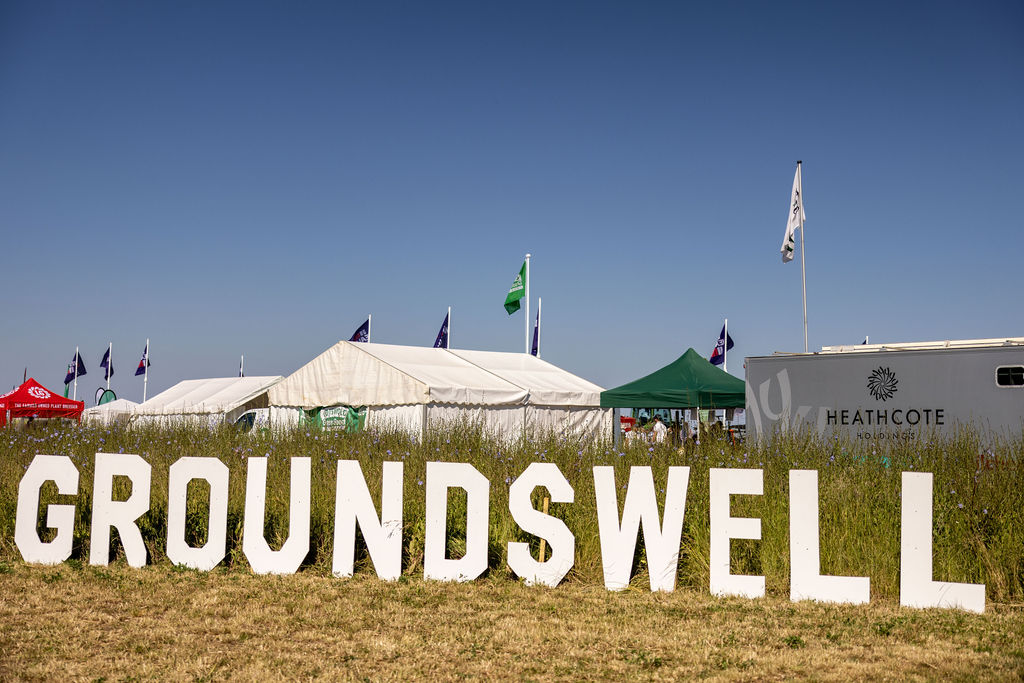
Groundswell 2022 Catchup
Farmers and growers flocked to the sixth annual Groundswell, the UK’s largest regenerative agricultural show in late
June this year. It was another sell-out event with 5,500 attendees who travelled to North Hertfordshire for two days of
information exchange, inspiration and a bit of liquid refreshment during the worst drought since 1976.Written by Alex Cherry
With over 140 sessions to attend, Groundswell offered a platform for household names, technical experts, experienced regenerative farmers and leading researchers to explore and debate the issues, opportunities, science and practices around regenerative agriculture. The event has grown from 500 farmers in a barn in 2016 as the “No-Till Show” to the two-day “Regenerative Agriculture Show and Conference” that it is today.
Although, one commentator referred to it as a “Festival of Ideas” which perhaps seems more appropriate given the scale and breadth of content. The eve before Groundswell is always exciting as people begin to arrive from all corners of the UK and beyond, pitching tents and getting the lay of the land. It is a chance to catch up with old friends and make new acquaintances in The Earthworm Arms Bar, where there were some enticing foodie offerings including different Pasture for Life meats cooked over fire. Dr Doolittle took to the decks and blasted out some disco classics which had mixed reviews from the audience, although a loyal cohort in Hawaiian shirts kept the energy going.
The camping area soon filled up with around 750 campers with all shapes and sizes of tents and campervans. On Wednesday morning Jill Clapperton kicked off proceedings in the Big Top tent, followed by Greg Judy advising farmers “How to think like a Grazier”. Across the 8 different session venues it was tough deciding what to go and see. Before the midday session a tribute was made to Caroline Drummond MBE, recognising her incredible achievements of 30 years leading LEAF, before her tragic passing in May.
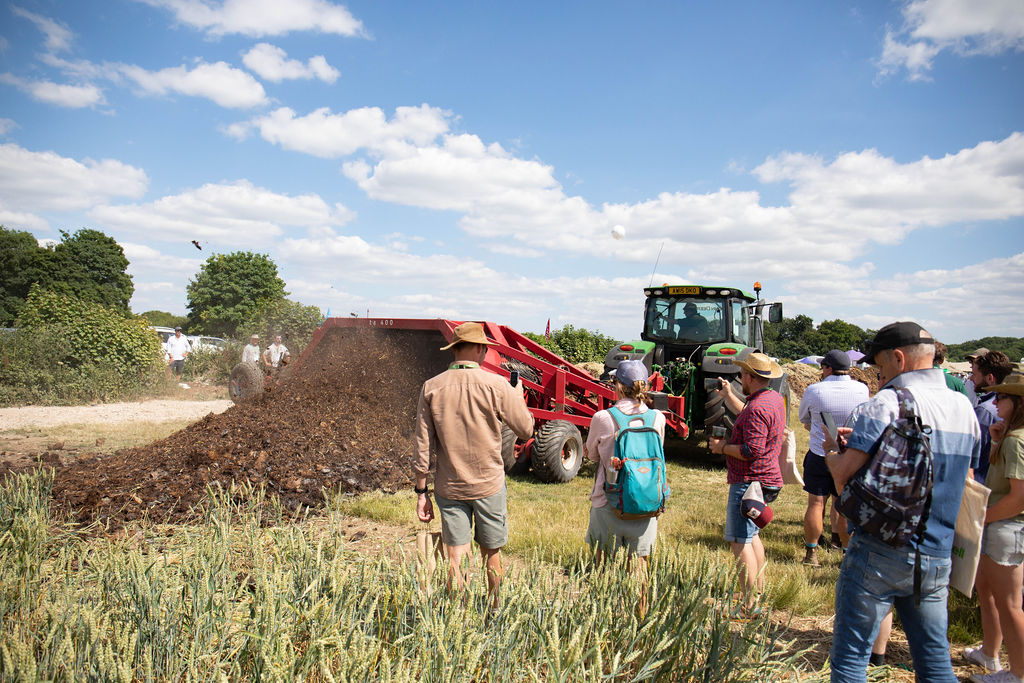
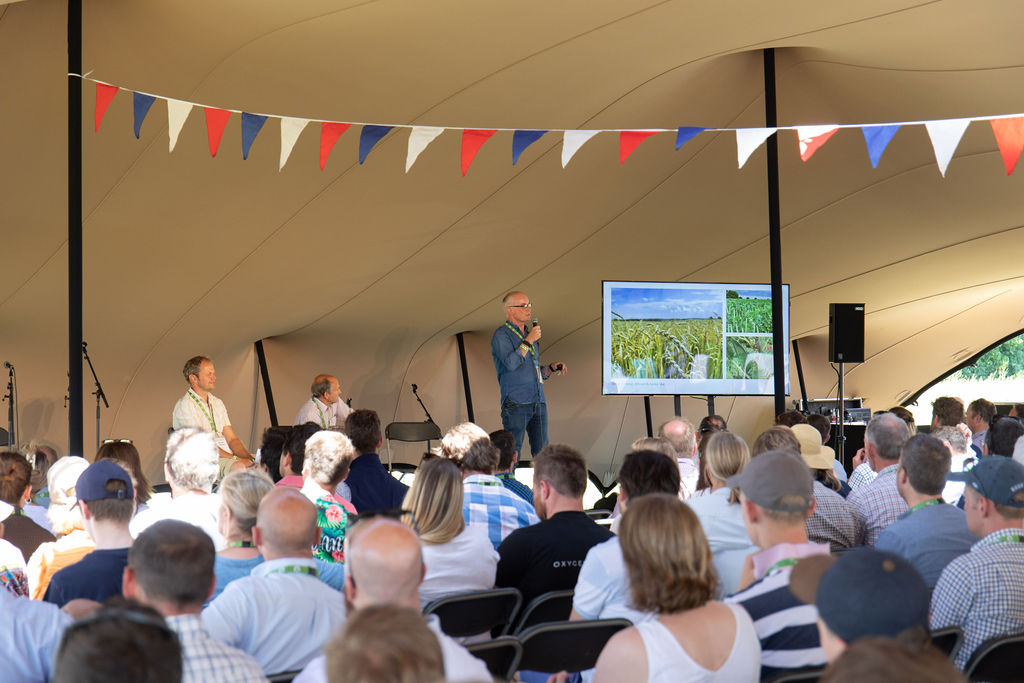
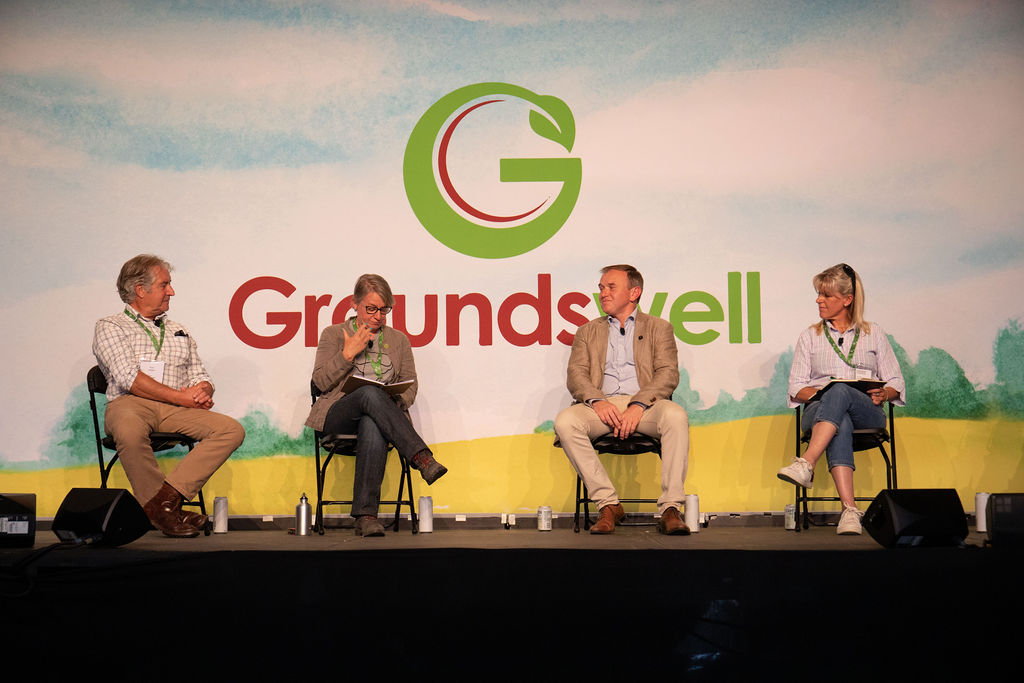
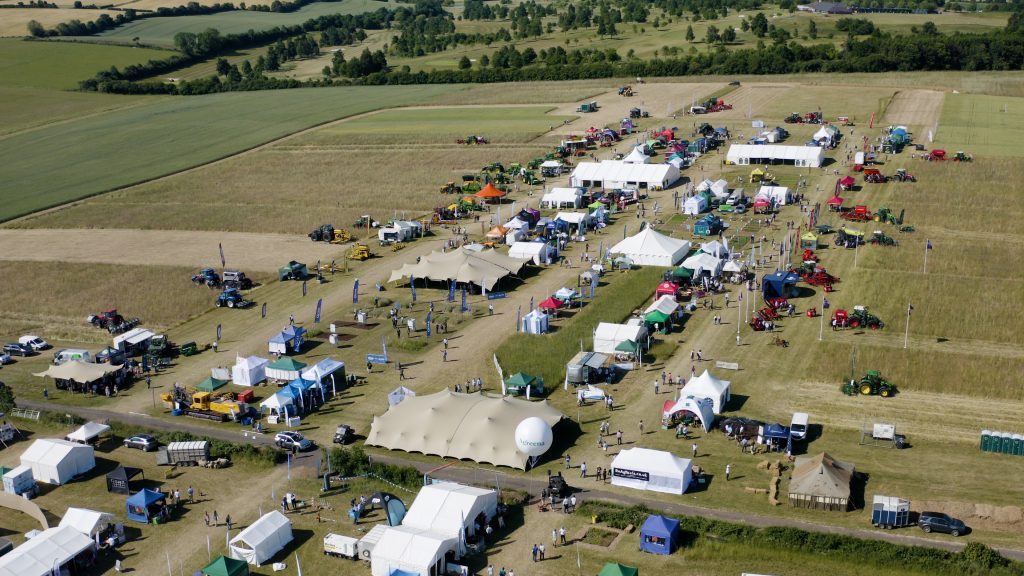


Henry Dimbleby provided a one year update to the National Food Strategy and Dwayne Beck from South Dakota asked “Are We Doing The “Right Things” Or Only Doing The Wrong Things Better?” Billy Lewis was announced as “Mixed Soil Farmer of the Year” and David Miller as the “Arable Soil Farmer of the Year” in the awards organised by Farm Carbon Toolkit. Tom Martin ran a very honest session entitled “Learn from My Mistakes”, a forum which was appreciated by the audience. The guest speaker that seemed to be on everyone’s tongue was George Monbiot who presented a well rehearsed synopsis of his latest book “Regenesis”.
The audience were broadly welcoming of this polarising debate on the future of food. It posed some difficult and highly-referenced points to disrupt the assumption that Regenerative Agriculture is the answer to feeding the planet. As a festival of ideas, it is important to challenge everything. It was noble of George to attend Groundswell, although it would have been even even more impressive had he stayed on for a couple of drinks in the Earthworm Arms to listen to some of the pioneering regenerative livestock farmers he rallies so strongly against.
Professor Lennart Olsson from Lund University in Sweden provided a fascinating update on the progress of the radical “perennial revolution” that the Land Institute and their global network are working on. After a stimulating and hot day, unsurprisingly the Earthworm Arms bar became the focal point for further in-depth analysis and discussion.
The beer was brewed in part by surplus bread from Toast Ale and brewing enthusiasts headed to the tour at Crossover Blendery where the beer is spontaneously fermented and flavoured by the fruit growing in the agroforestry on the farm. As the sun set, attendees got stuck in to some serious shape throwing on the dancefloor to the groove of funk and soul from DJ Krinks and, in the campsite, history was made as the first Groundswell marriage proposal took place and a happy couple announced their engagement, fittingly on the anniversary of their first embrace at Groundswell 2021.
We look forward to the first Groundswell wedding in 2023! Despite a few sore heads and one speaker declaring memory loss from the antics in the early hours, Thursday’s sessions kicked off with stimulating questions proposed: “How is big business adopting regenerative agriculture?” And “Does it make financial sense to go Regen?”. In the Demo Field the line up of manufacturers showcasing their direct drill machines included Weaving, Sky, Dale, Sam Agri, Horsch, Novag, Kverneland, Ryetec, Tuckwells, Amazon, Primewest, Claydon and Horizon.
The ground was very dry and the cover crop was bulky with rye volunteers and weeds. As a case study of an innovation born from a meeting at Groundswell, Small Robot Company and Tuckwell’s demonstrated their Treatment Maps Partnership – Tom robot can identify individual weeds in the field and also provide accurate plant counts in a growing crop, whilst also giving an accurate assessment of leaf colour and biomass assessment. This is converted into shape files readable by the sprayer which targets problem areas rather than applying a blanket application to the field.

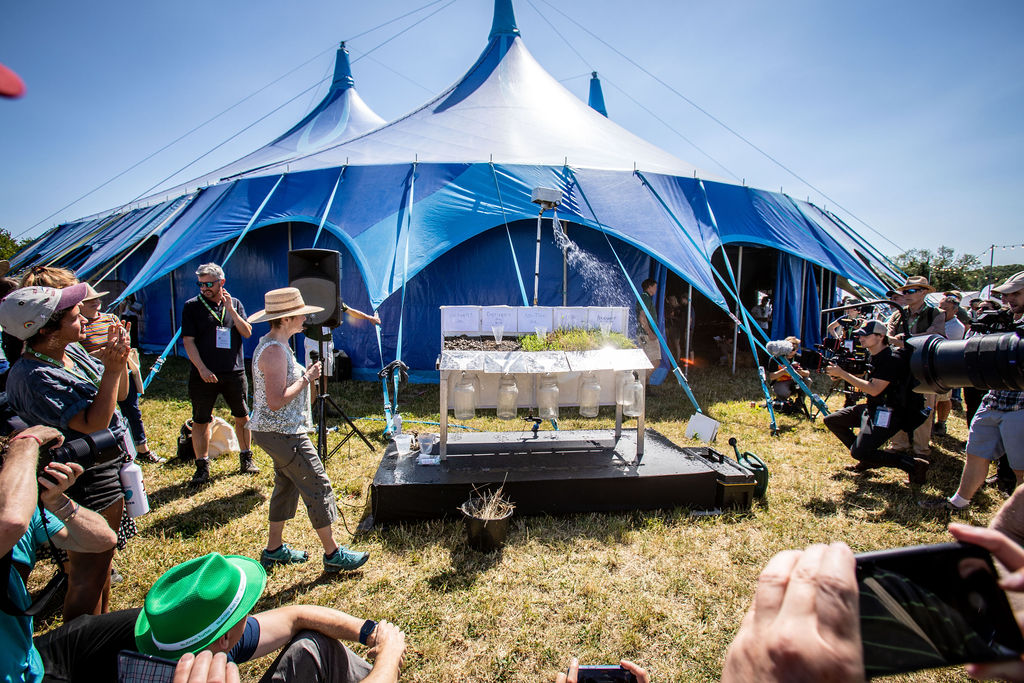
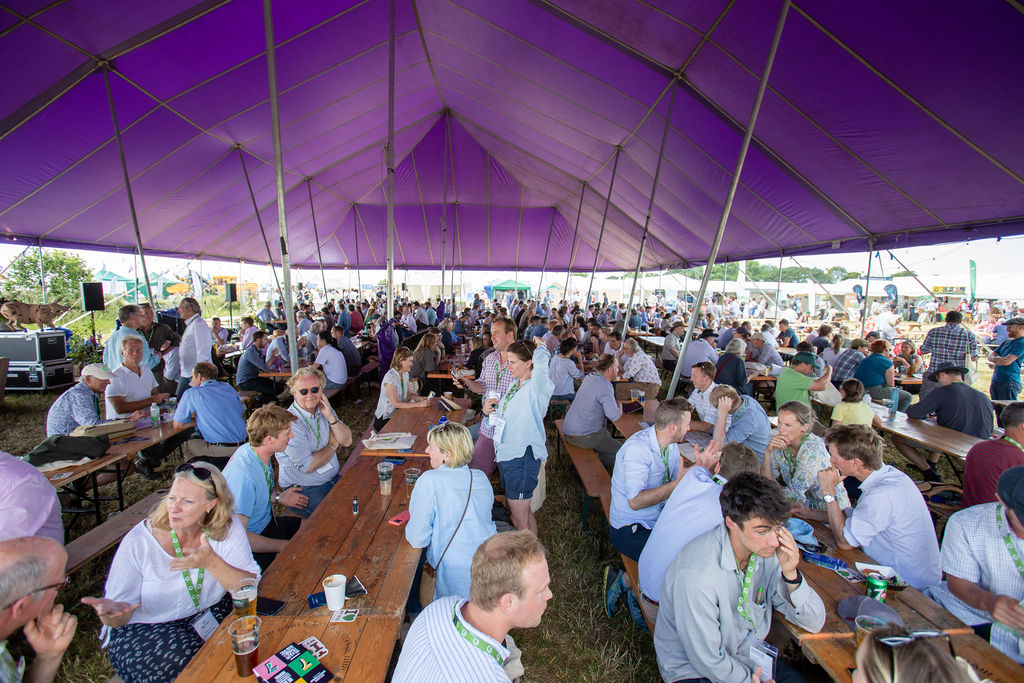
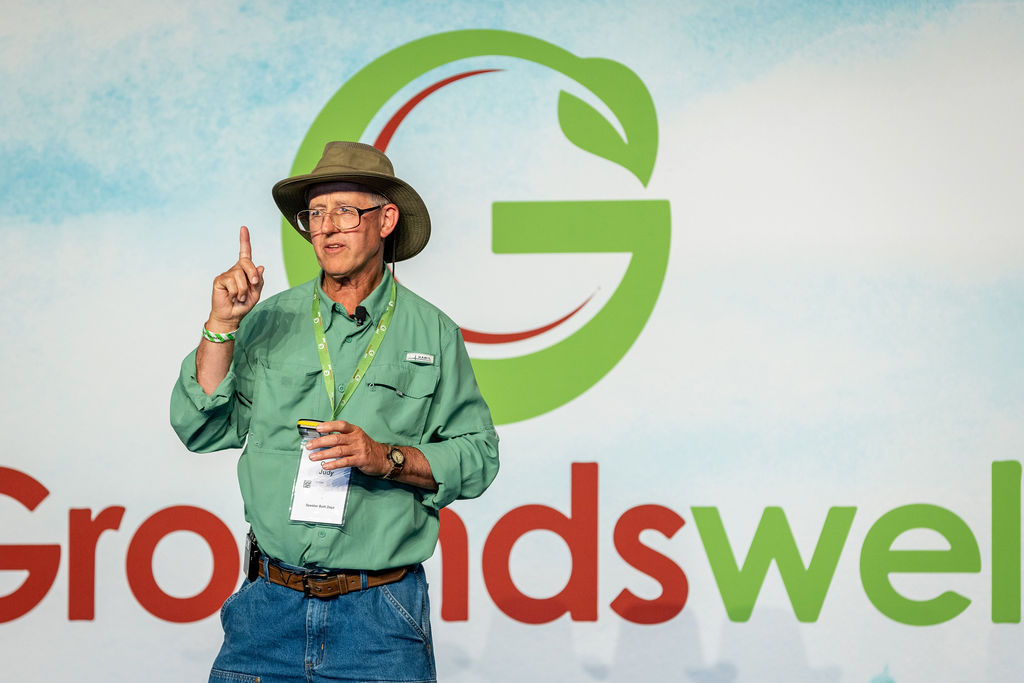
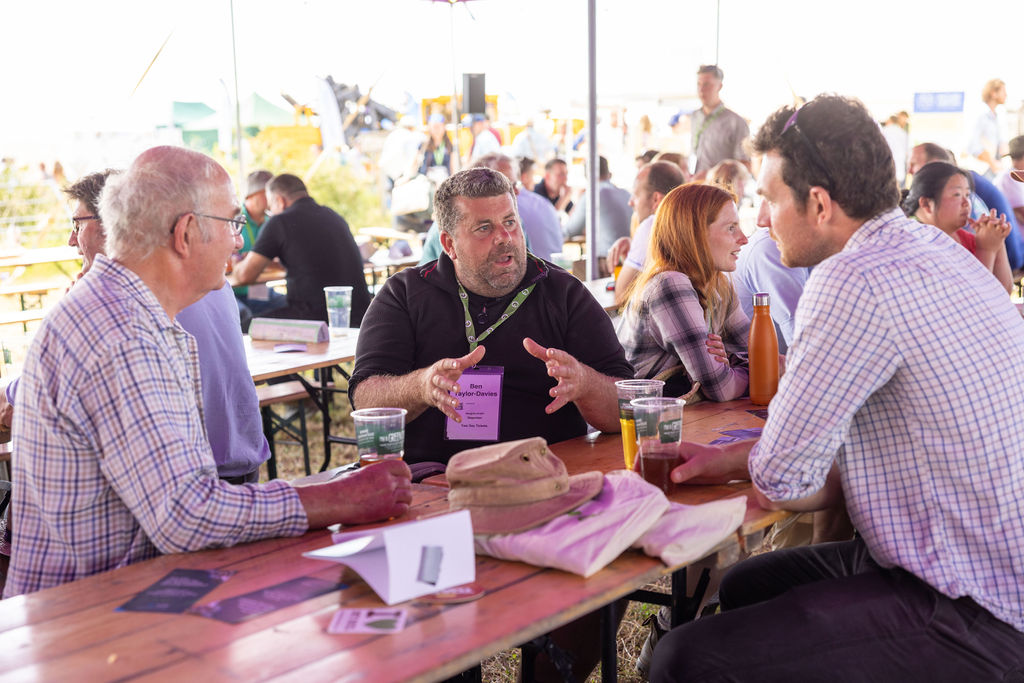
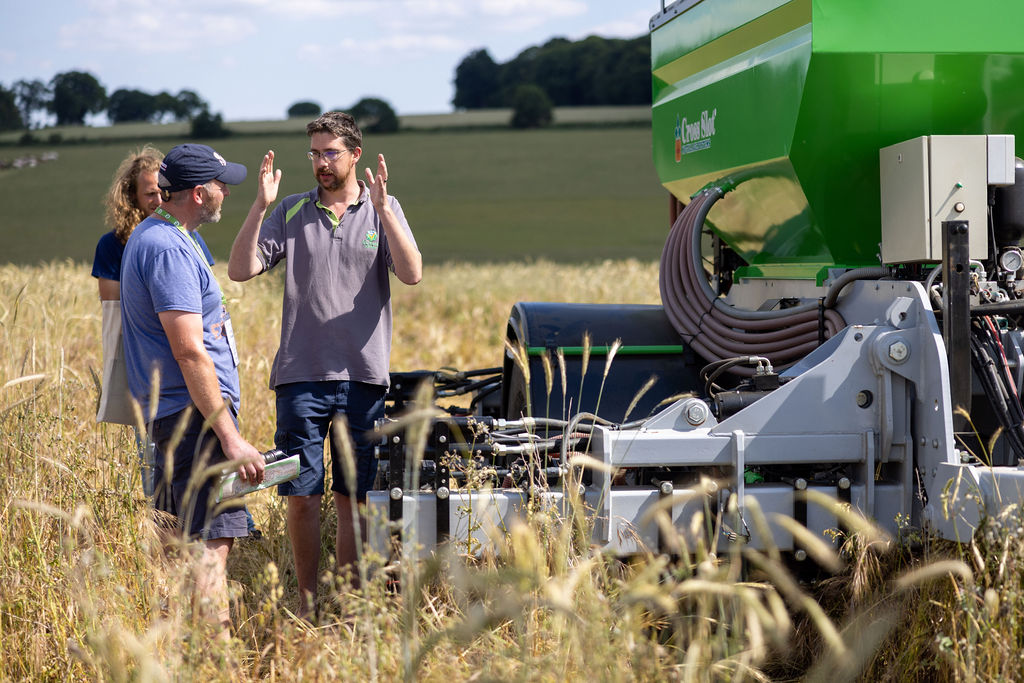
Defra Secretary of State George Eustice was joined on stage by: Minette Batters, tenant farmer and NFU President; Baroness Natalie Bennett, former leader of the Green Party; Tony Juniper, Chair of Natural England; in a panel chaired by Baroness Rosie Boycott, journalist and publisher. Commenting on the show, Eustice said “It’s amazing to see such creative thinking, new ideas being pioneered, new agronomic techniques and indeed, the rediscovery of old ones.” Elsewhere in the programme speakers tackled practical issues such as ‘do potatoes have a place in regen systems?’, ’Improved Nutrient Management with Zero Carbon Fertilisers” and ‘the threat of weeds for regenerative agriculture.’
Hosts John and Paul Cherry led a group to move the mob of beef shorthorns for the last session of the day with Greg Judy providing a refreshing and entertaining commentary on proceedings. We hope the show is re-energising and stimulates new ideas in this fast changing world we live in. If you missed some of the sessions in person, you can watch nearly all of them on the Groundswell YouTube channel. If you have an idea for a great session for next year applications are accepted via the Groundswell website.
We’re busy planning already, looking to expand on the offering for small-scale regenerative farmers, new entrants and market gardeners, while not forgetting the retail sector. We are also asking exhibitors to state what they are doing to support Regenerative Practices when they apply for a stand. We hope the show can continue to bring together a forward thinking community whilst regenerative agriculture becomes more widespread within the UK farming industry. Make sure you have the dates in your diary – 28th and 29th June 2023.




-
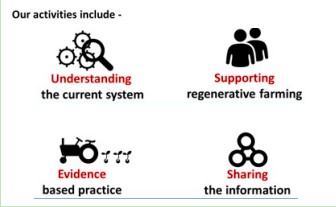
Fix Our Food – Transforming Food Systems In Yorkshire
This year the University of Leeds has launched a project researching regenerative farming systems in Yorkshire. This
project is part of the FixOurFood programme led by the University of York, funded by UK Research and Innovation,
a government fund to support research to investigate ways to transform the UK food system. As the challenge to
address the food system nationally is so large, the FixOurFood project is focusing on Yorkshire as a pilot region to
explore regenerative approaches that could be scaled to the UK and beyond. The project focuses on three areas of
innovation 1. sustainable and healthy food for children, 2. hybrid business models and 3. regenerative farming systems.Researchers from the University of Leeds Prof Lisa Collins, Prof Steve Banwart, Prof Pippa Chapman, Dr Gesa Reiss and Dr Ruth Wade, are leading the regenerative farming systems research in Yorkshire. Yorkshire has a large variety of farming systems, containing 13 – 17% of the UK’s crop production area and 10 – 14% of the UK’s livestock headcount, with a large diversity of soil and land cover in the region and an established network of innovative farmers. This makes Yorkshire a ideal place to investigate and understand the complex dynamics of farming systems. Together with key networks and alliances, the team at the University of Leeds are exploring existing examples of regenerative farming in the region, identifying the limiting environmental, social and economic factors, and discovering practical steps needed to support shifts towards regenerative farming. The research group will then determine what the regional potential is for implementation, and if regenerative agriculture could contribute to combat global warming if scaled up nationally.

Earlier this year, they released a survey to ask farmers what the University can do to support regenerative farming. Four key areas were identified which will be the focus of the project going forwards. From this survey they also sought to understand the opinions, opportunities, current activities and challenges associated with regenerative agriculture. To date, they have received 166responses, 147 (89%) said they were farmers and 79% from England. Responses came mostly from those already practicing elements of regenerative agriculture, with the majority of participants stating the main aim of regenerative agriculture was to ‘improve soil quality and fertility’ and the main motivation to move towards regenerative practices was to ‘improve soil health’. Most participants were using cover crops and direct drilling, and were most interested in reducing agrochemical inputs and increasing diversity in arable rotations. They felt the biggest challenge of moving towards regenerative agriculture was the ‘lack of information on good practice’, ‘lack of evidence’ and concerns over ‘reductions in yield’.
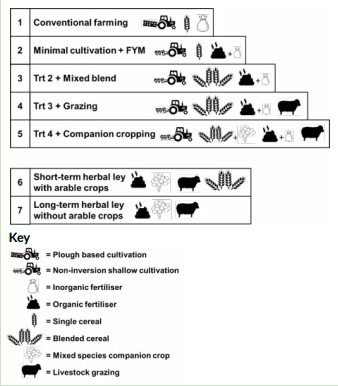
To support evidence-based practice, the University of Leeds is using its 317ha research farm to trial and test regenerative farming practices. The University of Leeds farm has been developed as a digitally connected smart-farm and terrestrial observatory. The main activity is a field-scale, replicated experiment using a historically conventionally managed field and measure the impacts of different transitions to regenerative agricultural practices on the soil, crop, greenhouse gas emissions and profit. This trial is in collaboration with NIAB whose Northern Regional Centre is based at the University of Leeds farm. The trial has been designed with advice from researchers and farmers from Yorkshire with seven treatments that range from a ploughed-based conventional farming system, through to significant changes in rotation and the inclusion of grazing livestock.
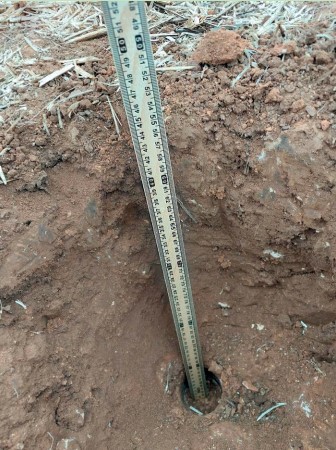
The experiment began last month but prior to any cultivations, Dr Ruth Wade led a team of researchers to collect baseline measurements of the soils current physical, chemical and biological status. The farm is on fine loamy soils(Aberford Series) and the team collected soil samples at 10cmintervals down to a depth of 50cm. These soil samples are currently being analysed in the lab for measurements such assoil structure, aggregate sizes, water holding capacity, carbon and nitrogen content. Throughout the trial, researchers from the project team will be measuring the impacts of the different transition approaches on soil health, crop growth, agronomy, greenhouse gas emissions, and economics. Soil sensors and automated greenhouse gas measurement chambers will be installed in the experimental plots to collect real-time high frequency measurements. In addition to collecting data, the trial will be used as a regional demonstration platform for farmers to view and discuss different management practices, and the learnings and outcomes will be fed back to the larger FixOurFood programme policy and governance team at City University.
We know from experience that soils must ‘earn’ the right to be direct drilled, which in practice means resolving any existing soil health issues before switching to a direct drill system. The soil assessments carried out by the researchers indicated that the historic intensive cultivations and high field traffic have caused soil structural issues that needed to be addressed. Therefore, the treatments transitioning to regenerative agriculture have received a non-inversion, shallow cultivation in the first year to alleviate the soil structural issues, whilst beginning the transition to regenerative management. Drilling will be carried out using a Ryetec MAAG SSP Direct Drill as it is a flexible machine allowing us to drill effectively across the range of cultivation treatments with one drill.
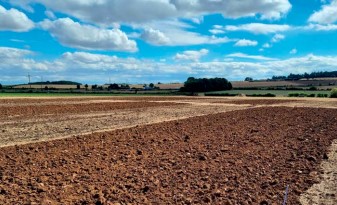
Pig manure was supplied by the University of Leeds National Pig Centre (based at the University of Leeds farm) and was spread on those plots receiving FYM using the Morley Agricultural Foundation small plot manure spreader that allowed the farmyard manure to be applied at a specific rate and only to those plots that required it. Companion crops and herbal ley seeds were broadcasted and rolled, and the establishment of winter wheat single varieties and winter wheat blends will happen in the autumn.

We will continue to monitor and report on the project, if you would like to know more information or sign up to the
newsletter please contact us through the FixOurFood website https://fixourfood.org/There are many farmers in Yorkshire exploring different management practices and we hope that this project is the start of a significant effort to support farmers in the region.
Dr Ruth Wade, University of Leeds
Dr Joseph Martlew, NIAB -

Farmer Focus – Tim Parton
Wow, yet another dry Spring/Summer. Anybody who doesn’t believe in climate change can hardly deny that temperature and weather conditions are changing!
This however especially just shows the importance of Carbon (as if it ever wasn’t important!) the extra water holding capacity was vital to keep crops going for those extra days in conditions such as these are vital. Did you know it takes 82 litres of water to grow one apple! Which is why we had small apples around here this year as we just did not get the vital ingredient (Water), we can be fantastic farmers but without water we are going nowhere!
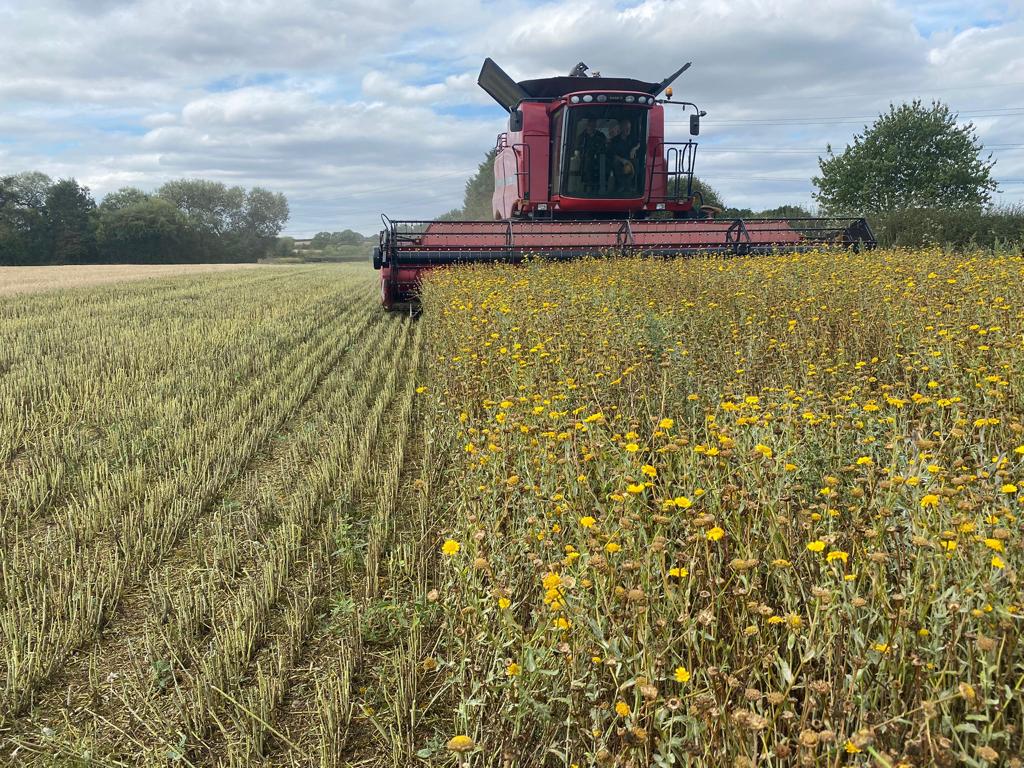
One crop which really stood out for me on that subject was my Spring Beans, since where I had not grazed my cover crops and drilled on the green using my crimper roller (made by TT engineering) to destroy the cover crop, I had got twice the crop of beans. This was because the soil had been thatched with cover crop, retaining water and keeping the soil cool, allowing biology to keep working for longer. Once soils dry out, biology goes dormant. Once again, I have grown beans with no herbicides, fungicides or insecticides, making them a viable GM: the ungrazed fields came in at 4.8/ha which for the year I was happy with; unfortunately, the grazed fields came in at half that! Has this changed my opinion of sheep? Yes and No. I feel the answer lies in what works on your own farm (as ever) but for me they are a tool which I can use when needed (we do not own our own sheep, they just come when invited). So, if I had a forward crop that needed reducing for different reasons as in disease etc I would use sheep as a tool to manage the crop! Will I be grazing in front of Beans? Defiantly not!
Fungicides are, I feel, now a distant memory for me (touch wood!) as once again they have not been used here! The difference in residue breakdown since ceasing their use is remarkable with debris gone very quickly digested by fungi as nature intended, with no barrier there to stop the breakdown.
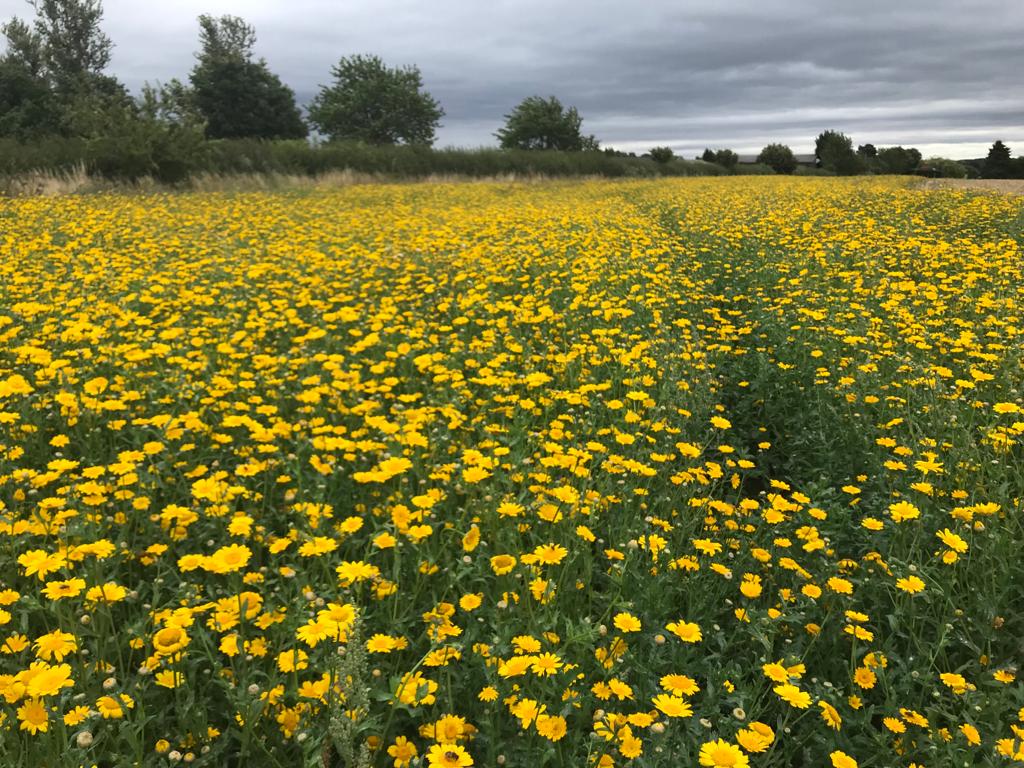

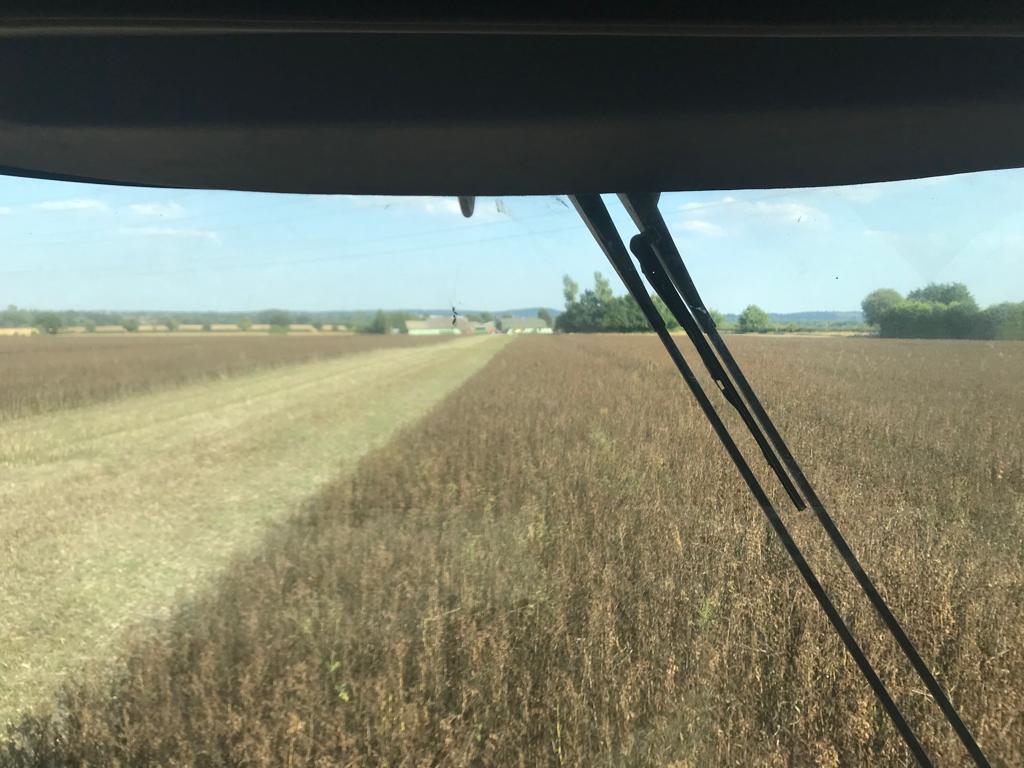
Wheat yields were very variable here from 7.5t/ha to 12t/ha; the highest yield coming from the foliar fed crop which was 50kg soil applied N and 28 l foliar applied N. I did a larger acreage of foliar applied this year (thank goodness). Using sap testing to monitor the crop allows me to put into practice that of Intelligent Farming which allows me to make informed decisions all the way through the growing season. My aim being to achieve top yields with the least investment, but I still do not class myself as a low input farmer as I will spend money if the likely return is going to be there. That is intelligent farming.
Working with Edaphos Agronomy we ran a large Nitrogen trial this year, which was not the easiest of Springs to run the trial, but it gave some remarkably interesting results! The most noticeable being that the 240kg/N/ha did not yield any more than 160 kg/ha and was exactly the same for my farm average of 120kg plus 10 L of foliar N. So, is this down to my soils producing more N? Or, was it just the fact that we did not get enough water? Whichever the reason a lot of money was saved across the farm from the old norm of 240kg! Which would have burnt out a lot of Carbon in its excess. Also, my C+arbon foot print for the crop is a lot lower giving me another income potential.
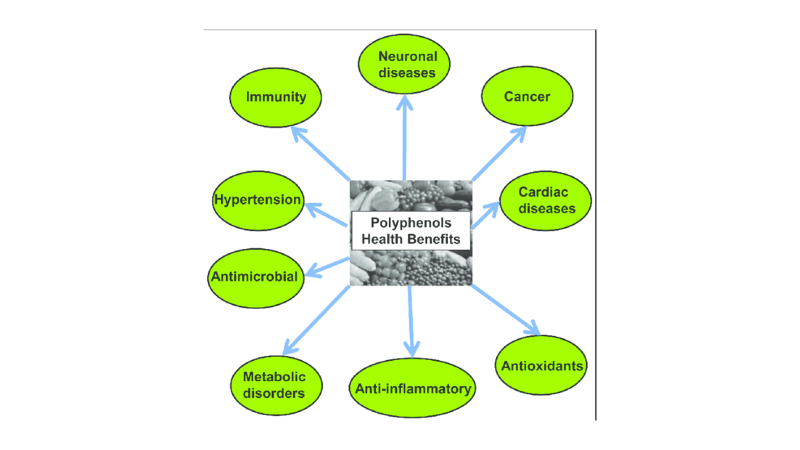
A new crop for me this year was growing Corn Marigolds and Corn Flowers for seed, for a company called “Yourgreen” who we work in partnership with as Green Farm Collective. These will go into seed packets to be grown on by individuals or companies who want to grow their own biodiversity to make a difference to the planet in which we live. This was a new experience for me regarding combine settings due to the crops having to be cut green! This takes some careful setting up as not to block the combine! A job which should be avoided at all costs! With combing achieved, the next challenge was drying the crop – don’t I just love a challenge! With such a small amount of seed, a different way was needed……and with the use of pallets and a big fan (see pictures) the job was achieved (result!)

As you all know, high nutrition food is always my aim on this journey and this year I have invested in the Bionutrient meter which can really start to tell me how good the food is in my garden and on the farm! This to me is really what growing healthy food is all about. Please see the picture to show what polyphenols do for us all! I have tested my wheat against some conventional wheat, and you can guess which came out top by a long margin! This for me is where I see food production going and will be bought on its health benefits.
On a lighter note, we have installed a new bird hide on the farm which is a fantastic addition now that we are trading our biodiversity: which has been done through Green Farm Collective in the form of cover crops and flower/bird food margins. This is a valuable new income to the farm and one which I hope will grow year on year! The story involved is a valuable story and one which the sponsor will use to sell their business in what they are doing to their customers. Days will include bird watching and the planting of trees which is all part of the package. Remember we as farmers are the heroes of the world as we are the only ones that can feed a growing population and heal the planet at the same time! Which is why it’s so important that we stand together (for once) and not sell ourselves short on the Carbon / Biodiversity market.


-
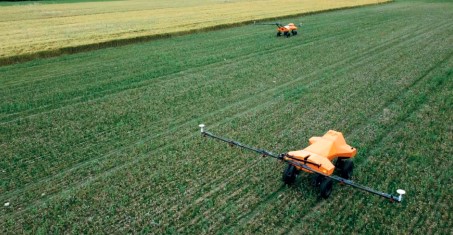
Small Robot Co Launches Robot Services To 50 Farms This Autumn
A major milestone for our small robots: our Tom monitoring robots will be set to work this Autumn. 50 farms will
become home to our sustainable robots, delivering our first services for Per Plant Farming: applications by exception.These autonomous scanning robots will help farmers make informed decisions on how to take action, cutting herbicides and fertilisers. Co designed with 35 farmer advisors and trial customers, including the Waitrose Leckford Estate, the Sainsbury family Lockerley Estate and the National Trust Wimpole estate, we are excited to see our technology in action commercially this growing season.
This is a big step forward in delivering real value to farmers. Partnering with leading John Deere dealer Tuckwells, we have integrated Tom’s treatment maps with existing precision sprayers, saving around 77% of herbicide, and estimated15% fertiliser savings. This will help farm businesses become both more environmentally and financially sustainable.
Transforming farming at the plant level
We see our bigger picture mission as helping farmers feed the world whilst regenerating the planet. Through the creation of a new farming model ‘Per Plant Farming’, we are making it possible to give farmers the confidence to only take action when it is required. Working with farmers to transform the system from the plant level, our sustainable farming robots Tom, Dick and Harry bring an entirely new way of farming. Using robotics and AI, we autonomously monitor and treat each crop plant. This means problem weeds can be targeted individually, as opposed to the whole field. This new model enables a highly precise approach to farming, which today is more important than ever before, as farmers face the volatility of the industry. Farmers are under increasing pressure, with input costs on the rise. Research from Harper Adams shows that up to 90% of inputs are wasted. This is not economically or environmentally viable.
Robotics gives huge scope to close the gap: delivering applications by exception. Precision monitoring alone can provide immediate value, optimising existing sprayers for herbicide and fertiliser applications. But we believe that’s just the tip of the iceberg in terms of the potential for what per-plant farming can deliver, both in input-cost savings and yield enhancement. Ultimately, input costs and environmental impact will be significantly minimised.

Commercial Service Launch
Our first commercial robots will soon be seen scanning across fields this2022-2023 growing season. The service will optimise farmer’s existing sprayer equipment to reduce costs and inputs. Per Plant Intelligence from our Tom monitoring robot means we treat only the problem areas: nutrient deficiencies, and weeds. Scanning the field, our Tom robot builds an understanding of where every plant is and what each one needs to achieve optimal performance. The data that is collected is then processed and detected by ‘Wilma’, our AI Advice Engine. Wilma then creates treatment maps to advise farmers on the most appropriate action to take. This information is used to inform variable rate fertiliser applications and to spot-apply herbicides through nozzle control and sectional control sprays. This gives farmers the confidence to take action only when required or even make ‘no spray’ decisions.
The 2022 service is fully subscribed, with 2023 orders now underway. 50farms have signed up to our ‘Farming as Service’, with groups of up to six local farmers joining together to forma ‘Pod’ of 120 ha. They will share a Tom robot, committing a minimum of 20ha each. This means farmers can try out the service on as little as 20ha, without a costly machinery outlay. Each farm will receive 4 scans of their wheat fields during a season. The new service offering will target winter wheat crop count and Per Plant visualisation; weed detection, geolocation and per plant imagery; glyphosate treatment sprayer export; herbicide treatment sprayer export; and fertiliser treatment sprayer export.
The launch follows the successful on-farm trials on three farms during the Autumn 2021 to 2022 growing season to develop the service. These trials included Waitrose Leckford Estate and the Lockerly Estate, owned by the Sainsbury family. The trials covered 118ha, locating 446M wheat plants in which 4.6M weeds were identified.
Precision weed control
The weed surveys conducted over the season by SRC highlighted the fact that a blanket approach to treating weeds is not only costly but often unnecessary. The surveys found that only a few areas were high in density: surprisingly only a few areas had weed density of more than weed/m². We then used this information to create heat maps, meaning farmers can treat only the problem areas, precisely. Our service enables farmers to assess weed density information for no spray decisions, and to reduce herbicide use by around 77% at a conservative estimate, depending on weed density and distribution.

Optimising crop nutrition
Farmers can also assess crop health and performance, reducing fertiliser costs by around 15%, as well as optimising crop nutrition. These are achieved through a combination of data including accurately gauging green area index and plant populations. The radical change here is that our monitoring service now allows for application by exception, rather than blanket precautionary measure. By also being precise in targeting weeds, our robots also help farmers protect biodiversity, preserving the natural environment, in particular strengthening soil health, which is essential to encourage optimal crop yield.
Longer term there is considerable potential for far greater savings. With rising fertiliser costs coupled with the industry attention on Net Zero, this has been in the spotlight, and is a strategic focus for our future roadmap. Fertiliser alone is a major contributor to agricultural emissions. This could have a huge contribution to reducing costs and carbon footprint, with no loss of crop productivity.
A robot’s eye view
Tom’s eight on-board cameras, mounted on a boom, deliver a ground sample distance of 0.39mm per pixel. Among the highest resolution of any crop-scanning technology, this gives Tom the capability to see individual water droplets on leaves and early signs of disease outbreak. SRC’s Tom monitoring robot scans the crop to a level of detail that identifies individual plants, gathering data on plant and weed distribution to determine the optimum treatment path. Tom will accurately geolocate and analyse data on every plant in the field. Tom can successfully identify all the wheat plants, determining precise plant counts, as well as broadleaf weeds. With a survey speed of 2.2ha/hr, Tom gathers 15,000 images from its cameras, or 40Gb of per plant intelligence, for every hectare.
Tuckwells partnership
To develop the sprayer integration we partnered with Tuckwells, one of the UK’s leading John Deere dealerships, which has a focus on industry-leading design and technology. In trials completed last spring, we created a treatment map for Tuckwells’,covering a 14.5ha field in Suffolk, achieving a 97% saving of an early spring herbicide. The trial data was run through JD’s Operation Centre and the treatment map for herbicide in wheat supplied to a Mazzoti sprayer with individual nozzle control over its36m boom.
The trial found that only 3% of the field actually needed to be sprayed(0.42ha), resulting in a herbicide saving of £24.48/ha. If the field had been treated with a JD R962i sprayer with 3m sectional control, it would have sprayed 13% of the field area, saving £21.96/ha. Another advantage for farmers is knowing how much will need to be applied before filling up the sprayer – what is put in the tank is what you use, nothing will be wasted. “We’ve been looking for the next innovation in precision application of herbicides and robotics seems to be the way forward,” says George Whelan, Tuckwell’s Group Technologies Manager, who coordinates their new technologies.
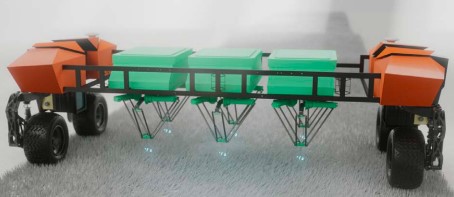
“Weed identification is the key and the AI element is the most exciting part. We can use the data from Wilma to create an application map and deliver real in-field solutions.”
Co-designed with Farmers
These results highlight the extensive potential for robotics within farming today. This will have a huge impact for farmers, reducing input costs, this in turn both increasing and optimising yields, whilst protecting the natural environment.
Our service is designed by farmers for farmers to create a farming system without compromise. Working with farmers to inform the developments of our technology has been invaluable. These close partnerships of more than5 years with our farmer advisors has enabled us to accurately pin-point the challenges and pain points to tackle providing a wealth of information. The foundations of our service are based on the farmer; technology should not take control, but rather work in partnership with farmers.
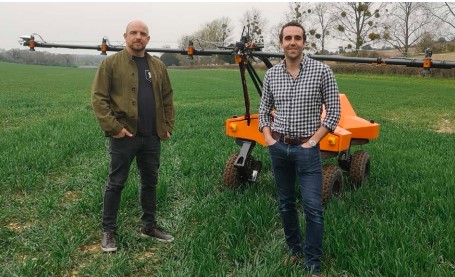
Accelerating regenerative
We believe these systematic changes in farming today are crucial in progressing towards regenerative farming practices. Stewardship for our soil health and the natural environment today is essential to ensure future generations can produce high quality crops both profitably and sustainably. Now is the time for us to work together to create a more ecologically harmonious farming model. For farmers – rightly – to be rewarded for their efforts. Farmers are integral to the environmental solution.
We’re excited to see our technology get to work on farms this season, but this is only the beginning. The potential is endless. Technological innovation will be a keystone in the Fourth Agricultural Revolution, and we’re honoured that our small robots are part of this revolutionary change. Helping build the food system of tomorrow.
-

FixOurFood means FixOurSoils
This year the University of Leeds has launched a project researching regenerative farming systems in Yorkshire. This project is part of the FixOurFood programme led by the University of York, funded by UK Research and Innovation, a government fund to support research to investigate ways to transform the UK food system. As the challenge to address the food system nationally is so large, the FixOurFood project is focusing on Yorkshire as a pilot region to explore regenerative approaches that could be scaled to the UK and beyond. The project focuses on three areas of innovation 1. sustainable and healthy food for children, 2. hybrid business models and 3. regenerative farming systems.
Researchers from the University of Leeds Prof Lisa Collins, Prof Steve Banwart, Prof Pippa Chapman, Dr Gesa Reiss and Dr Ruth Wade, are leading the regenerative farming systems research in Yorkshire. Yorkshire has a large variety of farming systems, containing 13 – 17% of the UK’s crop production area and 10 – 14% of the UK’s livestock headcount, with a large diversity of soil and land cover in the region and an established network of innovative farmers. This makes Yorkshire a ideal place to investigate and understand the complex dynamics of farming systems. Together with key networks and alliances, the team at the University of Leeds are exploring existing examples of regenerative farming in the region, identifying the limiting environmental, social and economic factors, and discovering practical steps needed to support shifts towards regenerative farming. The research group will then determine what the regional potential is for implementation, and if regenerative agriculture could contribute to combat global warming if scaled up nationally.
Earlier this year, they released a survey to ask farmers what the University can do to support regenerative farming. Four key areas were identified which will be the focus of the project going forwards.
From this survey they also sought to understand the opinions, opportunities, current activities and challenges associated with regenerative agriculture. To date, they have received 166 responses, 147 (89%) said they were farmers and 79% from England. Responses came mostly from those already practicing elements of regenerative agriculture, with the majority of participants stating the main aim of regenerative agriculture was to ‘improve soil quality and fertility’ and the main motivation to move towards regenerative practices was to ‘improve soil health’. Most participants were using cover crops and direct drilling, and were most interested in reducing agrochemical inputs and increasing diversity in arable rotations. They felt the biggest challenge of moving towards regenerative agriculture was the ‘lack of information on good practice’, ‘lack of evidence’ and concerns over ‘reductions in yield’.
To support evidence-based practice, the University of Leeds is using its 317ha research farm to trial and test regenerative farming practices. The University of Leeds farm has been developed as a digitally connected smart-farm and terrestrial observatory. The main activity is a field-scale, replicated experiment using a historically conventionally managed field and measure the impacts of different transitions to regenerative agricultural practices on the soil, crop, greenhouse gas emissions and profit. This trial is in collaboration with NIAB whose Northern Regional Centre is based at the University of Leeds farm. The trial has been designed with advice from researchers and farmers from Yorkshire with seven treatments that range from a ploughed-based conventional farming system, through to significant changes in rotation and the inclusion of grazing livestock.

Key

The experiment began last month but prior to any cultivations, Dr Ruth Wade led a team of researchers to collect baseline measurements of the soils current physical, chemical and biological status. The farm is on fine loamy soils (Aberford Series) and the team collected soil samples at 10cm intervals down to a depth of 50cm. These soil samples are currently being analysed in the lab for measurements such as soil structure, aggregate sizes, water holding capacity, carbon and nitrogen content. Throughout the trial, researchers from the project team will be measuring the impacts of the different transition approaches on soil health, crop growth, agronomy, greenhouse gas emissions, and economics. Soil sensors and automated greenhouse gas measurement chambers will be installed in the experimental plots to collect real-time high frequency measurements. In addition to collecting data, the trial will be used as a regional demonstration platform for farmers to view and discuss different management practices, and the learnings and outcomes will be fed back to the larger FixOurFood programme policy and governance team at City University.
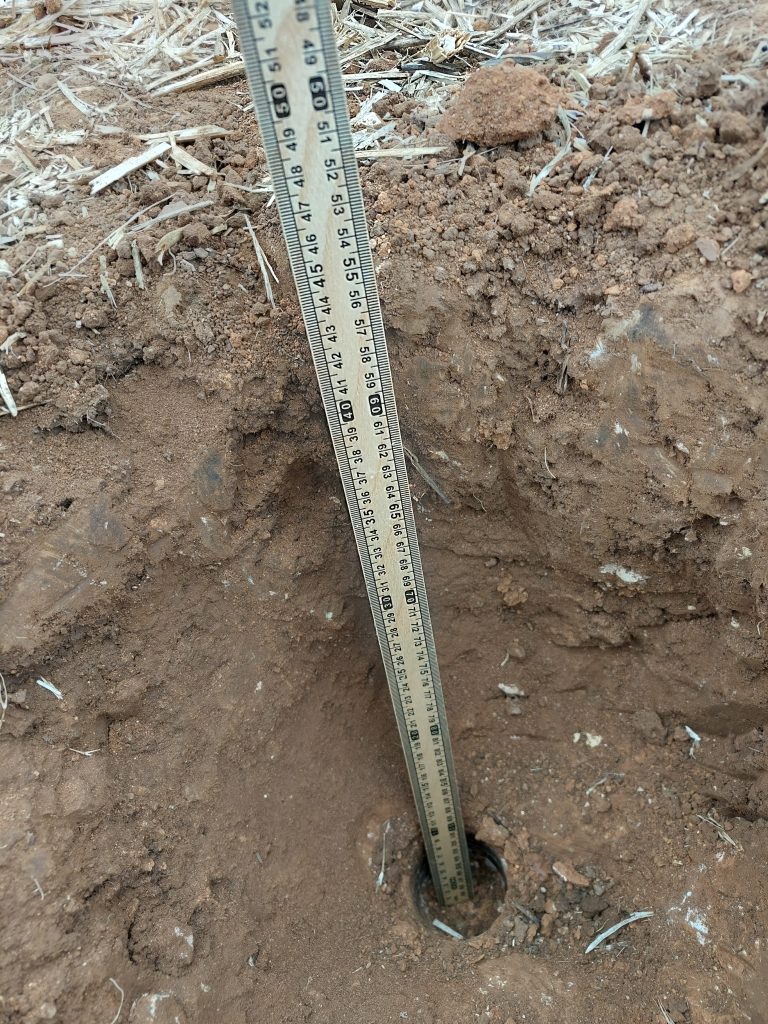
We know from experience that soils must ‘earn’ the right to be direct drilled, which in practice means resolving any existing soil health issues before switching to a direct drill system. The soil assessments carried out by the researchers indicated that the historic intensive cultivations and high field traffic have caused soil structural issues that needed to be addressed. Therefore, the treatments transitioning to regenerative agriculture have received a non-inversion, shallow cultivation in the first year to alleviate the soil structural issues, whilst beginning the transition to regenerative management. Drilling will be carried out using a Ryetec MAAG SSP Direct Drill as it is a flexible machine allowing us to drill effectively across the range of cultivation treatments with one drill.

Pig manure was supplied by the University of Leeds National Pig Centre (based at the University of Leeds farm) and was spread on those plots receiving FYM using the Morley Agricultural Foundation small plot manure spreader that allowed the farmyard manure to be applied at a specific rate and only to those plots that required it.
Companion crops and herbal ley seeds were broadcasted and rolled, and the establishment of winter wheat single varieties and winter wheat blends will happen in the autumn.
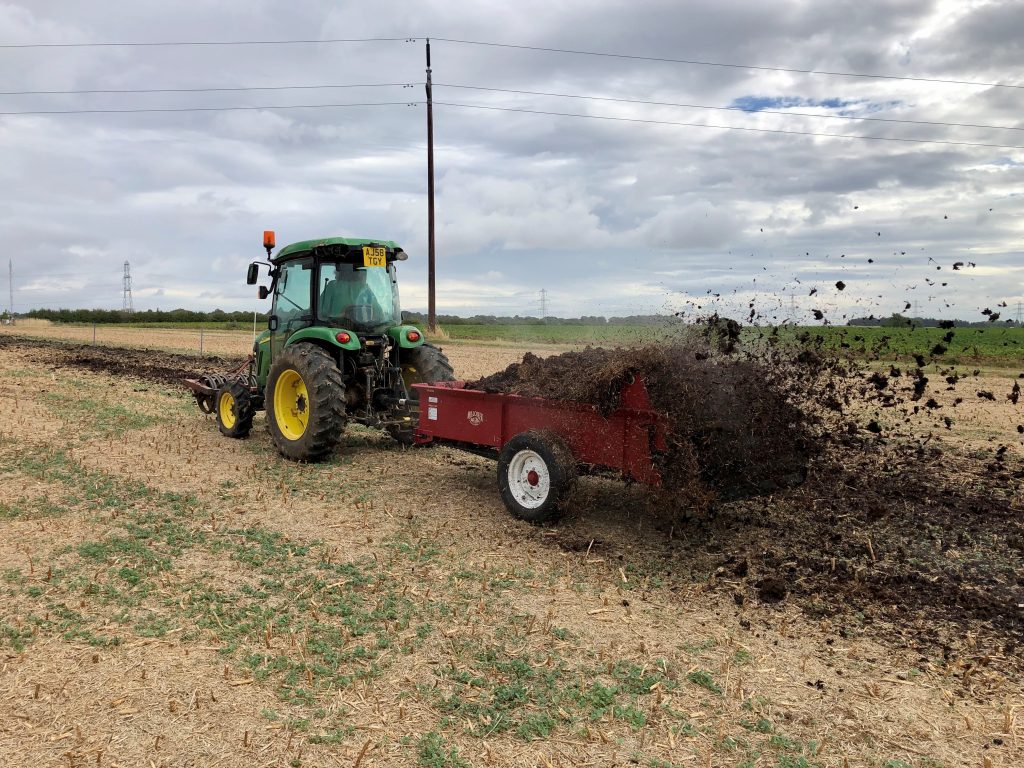
We will continue to monitor and report on the project, if you would like to know more information or sign up to the newsletter please contact us through the FixOurFood website https://fixourfood.org/
There are many farmers in Yorkshire exploring different management practices and we hope that this project is the start of a significant effort to support farmers in the region.
Dr Ruth Wade, University of Leeds
Dr Joseph Martlew, NIAB


-

Farmer Focus – Clive Bailye

Power Corrupts
There are two occasions in my farming year that remind me of the anticipation and trepidation felt as a child when my exam results or end of term school report were received. The first is of course harvest, yields being the score card for the team effort of all involved in every part of the growing process. As the loads roll in and pass over the weighbridge filling barns we reflect upon what we got right and what we got wrong in the seemingly never-ending, life long quest for growing perfection that only a farmer can ever understand. It is this that drives, innovates and motivates never ending improvement for the next year.
The reality however is we are all, mostly, out of control of the yield outcome. That “goldilocks” year of not too wet, not too dry, not too hot or not too cold rarely, if ever, comes and there is always something that could have been done better or at different timing with the benefit of hind sight. This year I suspect many will be reflecting upon agronomic decisions such as how different synthetic fertiliser rates and strategies have impacted yield (or not) or variety and input timing choice but in truth, what will have determined all our yields more than any other factor will be the soil we have and the weather we got.
The second set of results is the end of our financial year which runs with the calendar to the 1st of January and this is the really important set of results that reflect our management of the business and its ability to adapt to whatever season we are dealt, financial performance is something we have almost complete control over, our input /output buying and selling decisions, our labour and machinery spends and our agronomic strategy can all be adapted as inevitably weather and trading situations change.

I do say “almost” complete control however as there is nearly always something unexpected and an element of luck that could never be planed for or expected by even the most perfect of management business plan, that unexpected major mechanical failure or that out of the blue ill health or personal issue.
Whilst financial contingency for that u n e x p e c t e d breakdown can be budgeted for to some extent it’s the latter personal and staffing issues that can be a lot harder to plan for and disruptive to workload, time cannot be easily bought, or can it?
For an arable farm to be profitable these days requires absolute focus on minimising fixed costs. Highly skilled operators are both one of the harder to find and more increasingly expensive resources for many farms. Larger machinery has provided great opportunity to reduce the need for so many to be involved in establishment, care and harvesting of crops and although larger, higher output machines are of course more expensive their cost is somewhat mitigated by the needs for far fewer of them to complete workloads in a timely fashion.

Regardless of a farms establishment strategy the trend to larger machinery has been common over the last couple of decades. At the start of my farming career our “big” tractor was a Ford 8240, which I think was just about 100hp. That tractor comfortably ploughed and established all our crops with a power harrow combination drill on around 250 arable acres we farmed at the time, I can’t recall ever thinking we needed more power but did aspire to a 8340 or even a mighty TW model one day …….. just “because” my neighbours had one. Vanity and ego can be an expensive aspiration for a young farmer as I would learn.
As acres farmed grew, labour became harder to find and justify, the tractors got bigger to pull increasingly wide cultivation and drilling equipment. Eventually power no longer seemed the limiting factor and traction did. The more powerful tractors had got a lot heavier the 270 hp John Deere 8410 we had “grown into” being more than twice the weight of that 90hp Ford 7810 and despite big advances in tyre technology and large sizes somewhat reducing the damage to soils that weight can do tracks were the inevitable next step, first 8520T’s and ultimately the pinnacle of BIG tractors at the time the mighty Challenger 875, all 25t and over 600hp of it!
Pulling the (very on trend at the time) Simba solo followed by a Vaderstad rapid cultivator drill it offered massive outputs vs that old 90hp plough / combi drill system, one man was comfortably establishing probably ten times the area that the Ford 8240 was capable of. It came at a cost however and despite that x10 capacity of work I have a suspicion it may have had a cost in both capital and running costs that was more thanx10 the 100hp system! Many large arable farms still run similar systems today, many will claim it’s “cheaper” to do so quoting all sorts of nonsense about economies of scale and paying high rents or entering contract farming arrangements to justify the machinery. It rarely is however, and I will be honest, the main reason I had a 610hp tractor back in 2007 was really because I wanted a 610hp tractor……. I probably just made the rest and the numbers “fit”. I don’t think I’m the first or will be the last young and ambitious farmers to apply such warped logic to my thinking.
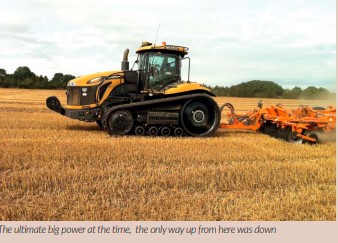
So, what problem does big solve? the answer is labour, “big” does buy time. The ten 90hp tractors needed to cover the same workload we had at the time would have required 10 skilled operators, skilled labour is hard to find on a seasonal basis and on a purely combinable cropped farm the labour requirement is for relatively small periods of the year. Fewer full-time staff equals less costs and less problems, easier management, fewer of the most unpredictable of variables, people. However as is so often the case, as you solve one problem you create others. Power corrupts, it allows you to do things you probably shouldn’t like to cultivate too deep or in conditions that you shouldn’t. It changes mindset about what we need, writing this article I really find it hard to believe that just 20years ago a 100hp tractor was all we ever needed, it seems that once your goal post has been moved its hard to remember what was possible.
Power adds weight, lots of weight! combined with that ability to force work when conditions are not right that power can quickly add up to a lot of damage to soils, this damage needs cultivation to fix it and so the vicious circles begins where cultivation creates the need for cultivation, power requirement increases and costs spiral. This “hamster wheel” of tillage farming is very difficult to break and faced with solving that many are simply unable to accept that it is even possible to do so. For every no-till farmer I have ever met evangelical about the change to his soils and bottom line I come across a similar number of farmers, equally as convinced they have no choice but to cultivate, their soils are somehow “different”, their farm is somehow “different”, they are somehow “different”. They may well be right, farming in the UK is anything but consistent and every farm is indeed different, there is no rule book on crop establishment and my advice to any farmer is do what works and what you are comfortable with, only change if you either want or need to.
A good exercise for any farmer is to look back at what power levels they were using and felt they needed 20yrs ago on their soils and ask themselves if they could manage with that today? If for any other reason than increased workload the answer is not then something is wrong, your soil and your farm is not moving forward, and the situation is probably not sustainable, just maybe that is highlighting the need for change even if that change may not always be a comfortable one, maybe the need to change is greater than you realise?
Moving to direct drilling of course offers an alternative way to cut the labour fixed cost but this time in a very different way to the high horsepower route. By removing the entire operation of cultivation the hours required in the seat are massively reduced. This allowed us to get away from the painful costs of the big tractors and return to what has always felt to me like a much more sensible size and cost of versatile machines.
We began with a second-hand 4m direct drill and had a240hp tractor pull it which was too big for that drill, the tractor size being based around where the best deals were and a power requirement to pull large grain trailers at harvest and facilitate move away from costly self-propelled sprayers to trailed alternative rather than dictated by high draft cultivators and drills.

The 4m drill successfully proved the no-tillage concept to us and was quite quickly replaced by a 6m version of the same brand that felt better paired to the tractor. Direct drills are much lower draft requirement than their min-till or cultivation counterparts. Wider row spacings means today we power a12m direct drill with the same 240hp tractor, that gives work rates of up to 300ac a day possible if fields are large enough and logistics can keep up. It is a truly huge capacity way beyond that of any establishment system we ever had before, far more than we need in fact affording us the luxury choosing our timing, improving the agronomic prospects of the crop hopefully and importantly reducing our risk of failure due to factors beyond our control like weather. This time “Big” has bought us time whilst genuinely reducing fixed costs and not just moving those cost from the labour column to the machinery column in those important budgets and year end accounts. This time “Big” makes business sense and is no longer ego.
-
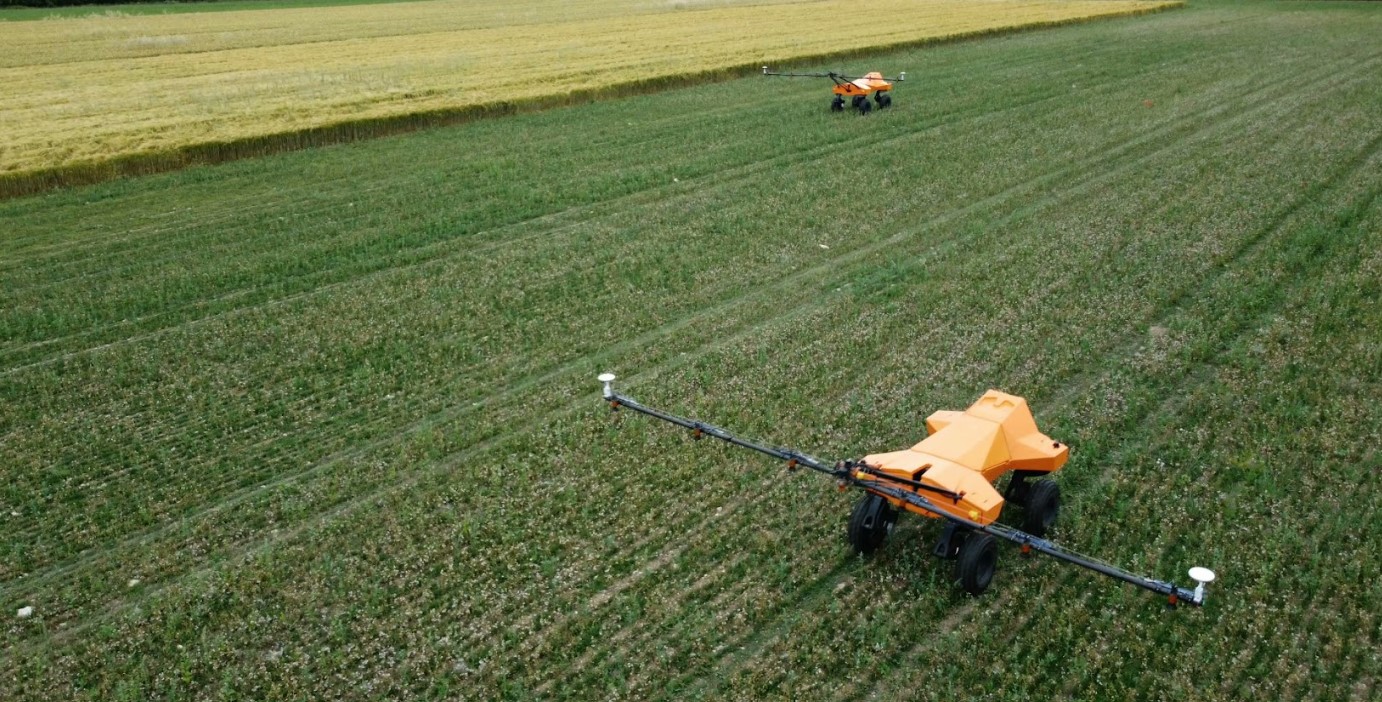
Small Robot Co launches robot services to 50 farms this autumn
A major milestone for our small robots: our Tom monitoring robots will be set to work this Autumn. 50 farms will become home to our sustainable robots, delivering our first services for Per Plant Farming: applications by exception. These autonomous scanning robots will help farmers make informed decisions on how to take action, cutting herbicides and fertilisers.
Co-designed with 35 farmer advisors and trial customers, including the Waitrose Leckford Estate, the Sainsbury family Lockerley Estate and the National Trust Wimpole estate, we are excited to see our technology in action commercially this growing season. This is a big step forward in delivering real value to farmers. Partnering with leading John Deere dealer Tuckwells, we have integrated Tom’s treatment maps with existing precision sprayers, saving around 77% of herbicide, and estimated 15% fertiliser savings. This will help farm businesses become both more environmentally and financially sustainable.
Transforming farming at the plant level
We see our bigger picture mission as helping farmers feed the world whilst regenerating the planet. Through the creation of a new farming model ‘Per Plant Farming’, we are making it possible to give farmers the confidence to only take action when it is required. Working with farmers to transform the system from the plant level, our sustainable farming robots Tom, Dick and Harry bring an entirely new way of farming.
Using robotics and AI, we autonomously monitor and treat each crop plant. This means problem weeds can be targeted individually, as opposed to the whole field. This new model enables a highly precise approach to farming, which today is more important than ever before, as farmers face the volatility of the industry. Farmers are under increasing pressure, with input costs on the rise. Research from Harper Adams shows that up to 90% of inputs are wasted.
This is not economically or environmentally viable. Robotics gives huge scope to close the gap: delivering applications by exception. Precision monitoring alone can provide immediate value, optimising existing sprayers for herbicide and fertiliser applications. But we believe that’s just the tip of the iceberg in terms of the potential for what per-plant farming can deliver, both in input-cost savings and yield enhancement. Ultimately, input costs and environmental impact will be significantly minimised.
Commercial Service Launch
Our first commercial robots will soon be seen scanning across fields this 2022-2023 growing season. The service will optimise farmer’s existing sprayer equipment to reduce costs and inputs. Per Plant Intelligence from our Tom monitoring robot means we treat only the problem areas: nutrient deficiencies, and weeds. Scanning the field, our Tom robot builds an understanding of where every plant is and what each one needs to achieve optimal performance. The data that is collected is then processed and detected by ‘Wilma’, our AI Advice Engine.
Wilma then creates treatment maps to advise farmers on the most appropriate action to take. This information is used to inform variable rate fertiliser applications and to spot-apply herbicides through nozzle control and sectional control sprays. This gives farmers the confidence to take action only when required or even make ‘no spray’ decisions. The 2022 service is fully subscribed, with 2023 orders now underway. 50 farms have signed up to our ‘Farming as Service’, with groups of up to six local farmers joining together to form a ‘Pod’ of 120 ha.
They will share a Tom robot, committing a minimum of 20ha each. This means farmers can try out the service on as little as 20ha, without a costly machinery outlay. Each farm will receive 4 scans of their wheat fields during a season. The new service offering will target winter wheat crop count and Per Plant visualisation; weed detection, geolocation and per plant imagery; glyphosate treatment sprayer export; herbicide treatment sprayer export; and fertiliser treatment sprayer export. The launch follows the successful on-farm trials on three farms during the Autumn 2021 to 2022 growing season to develop the service.
These trials included Waitrose Leckford Estate and the Lockerly Estate, owned by the Sainsbury family. The trials covered 118ha, locating 446M wheat plants in which 4.6M weeds were identified.
Precision weed control
The weed surveys conducted over the season by SRC highlighted the fact that a blanket approach to treating weeds is not only costly but often unnecessary. The surveys found that only a few areas were high in density: surprisingly only a few areas had weed density of more than weed/m². We then used this information to create heat maps, meaning farmers can treat only the problem areas, precisely. Our service enables farmers to assess weed density information for no spray decisions, and to reduce herbicide use by around 77% at a conservative estimate, depending on weed density and distribution.
Optimising crop nutrition
Farmers can also assess crop health and performance, reducing fertiliser costs by around 15%, as well as optimising crop nutrition. These are achieved through a combination of data including accurately gauging green area index and plant populations. The radical change here is that our monitoring service now allows for application by exception, rather than blanket precautionary measure. By also being precise in targeting weeds, our robots also help farmers protect biodiversity, preserving the natural environment, in particular strengthening soil health, which is essential to encourage optimal crop yield. Longer term there is considerable potential for far greater savings. With rising fertiliser costs coupled with the industry attention on Net Zero, this has been in the spotlight, and is a strategic focus for our future roadmap. Fertiliser alone is a major contributor to agricultural emissions. This could have a huge contribution to reducing costs and carbon footprint, with no loss of crop productivity.
A robot’s eye view
Tom’s eight on-board cameras, mounted on a boom, deliver a ground sample distance of 0.39mm per pixel. Among the highest resolution of any crop-scanning technology, this gives Tom the capability to see individual water droplets on leaves and early signs of disease outbreak. SRC’s Tom monitoring robot scans the crop to a level of detail that identifies individual plants, gathering data on plant and weed distribution to determine the optimum treatment path.
Tom will accurately geolocate and analyse data on every plant in the field. Tom can successfully identify all the wheat plants, determining precise plant counts, as well as broadleaf weeds. With a survey speed of 2.2ha/hr, Tom gathers 15,000 images from its cameras, or 40Gb of per plant intelligence, for every hectare.

Tuckwells partnership
To develop the sprayer integration we partnered with Tuckwells, one of the UK’s leading John Deere dealerships, which has a focus on industry-leading design and technology. In trials completed last spring, we created a treatment map for Tuckwells’, covering a 14.5ha field in Suffolk, achieving a 97% saving of an early spring herbicide. The trial data was run through JD’s Operation Centre and the treatment map for herbicide in wheat supplied to a Mazzoti sprayer with individual nozzle control over its 36m boom.
The trial found that only 3% of the field actually needed to be sprayed (0.42ha), resulting in a herbicide saving of £24.48/ha. If the field had been treated with a JD R962i sprayer with 3m sectional control, it would have sprayed 13% of the field area, saving £21.96/ha. Another advantage for farmers is knowing how much will need to be applied before filling up the sprayer – what is put in the tank is what you use, nothing will be wasted. “We’ve been looking for the next innovation in precision application of herbicides and robotics seems to be the way forward,” says George Whelan, Tuckwell’s Group Technologies Manager, who coordinates their new technologies. “Weed identification is the key and the AI element is the most exciting part.
We can use the data from Wilma to create an application map and deliver real in-field solutions.”
Co-designed with Farmers
These results highlight the extensive potential for robotics within farming today. This will have a huge impact for farmers, reducing input costs, this in turn both increasing and optimising yields, whilst protecting the natural environment.
Our service is designed by farmers for farmers to create a farming system without compromise. Working with farmers to inform the developments of our technology has been invaluable. These close partnerships of more than 5 years with our farmer advisors has enabled us to accurately pin-point the challenges and pain points to tackle providing a wealth of information. The foundations of our service are based on the farmer; technology should not take control, but rather work in partnership with farmers.

Accelerating regenerative
We believe these systematic changes in farming today are crucial in progressing towards regenerative farming practices. Stewardship for our soil health and the natural environment today is essential to ensure future generations can produce high quality crops both profitably and sustainably. Now is the time for us to work together to create a more ecologically harmonious farming model. For farmers – rightly – to be rewarded for their efforts. Farmers are integral to the environmental solution. We’re excited to see our technology get to work on farms this season, but this is only the beginning. The potential is endless. Technological innovation will be a keystone in the Fourth Agricultural Revolution, and we’re honoured that our small robots are part of this revolutionary change. Helping build the food system of tomorrow.




